Author: Larry St Aubin
The traditional land of the Anishinaabeg”. The Anishinaabeg (plural form of Anishinaabe) live from the Ottawa River Valley west across Northern Ontario and to the plains of Saskatchewan south to the northeast corner of North Dakota, northern Minnesota and Michigan, as well as the northern shores of Lakes Ontario and Erie. The Ojibwe, Chippewa, Odawa, Potawatomi, Algonquin, Saulteaux, Nipissing and Mississauga First Nations are Anishinaabeg.” Canadian Encyclopedia
Say what you will, when I have a long drive and need to get an early start, Tim Horton’s is there for me. Either it is 24 hours or opens at 6 am – like the one in Wawa.
We continue our cresting of Lake Superior’s north show – heading to Thunder Bay. One of my favourite drives. The largest fresh water lake in the world by surface area. Actually, because of its size, weather patterns, and force, it is considered an “inland sea”. It is more than just a lake. Known to the Ojibwe as gitchi-gami or Gitche Gumee. On our 2019 road trip, we stopped in Wawa where Eve and Raisin posed in front of a carving of Gitchee Goomee.
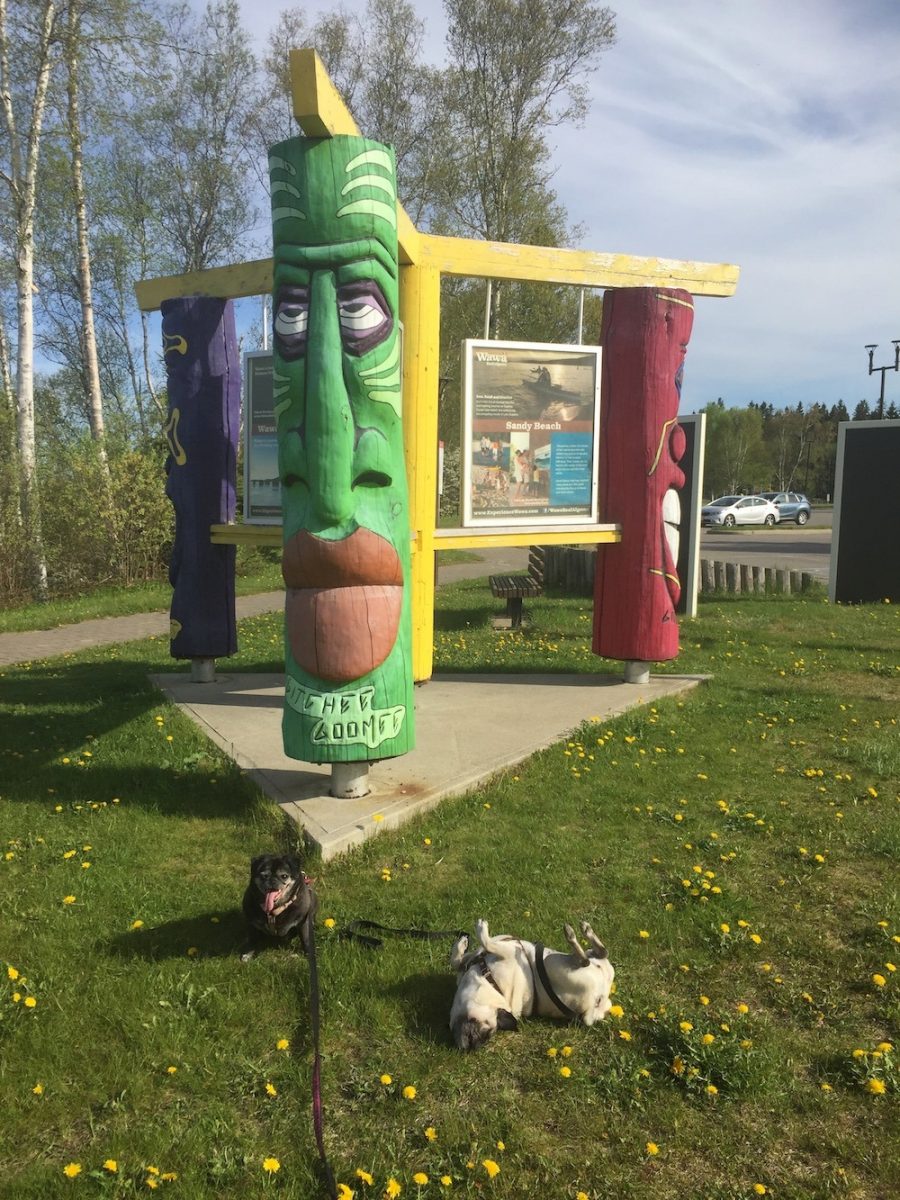
The Tree Fires Confederacy. A confederacy between the Boodiwaadmi, Ojibwe and the Odaawa that pre-existed before European contact. This confederacy outlined a process on how the relationship with the settlers would occur. The Odaawa would trade goods with the settlers and form relationships with them in terms of trading. The Ojibwe would be the knowledge keepers and would pass this down to all of the nations. The Boodiwaadmi were to take care of the three fires (nations) and make sure they were strong. The fire is central to the governance structure and continues to be so to this day. All the different groups have their own roles and responsibilities to ensure the nation as a whole thrives.
The Visitor Room. It is a 5 hour drive between Wawa and Thunder Bay so decided to stop at Terrace Bay for a coffee and pee break. It’s 3 hours from Wawa. Tim Horton’s is convenient at 6 am but I like to support independent coffee shops when I can. Also the gas tank was sliding toward empty and there are few and far between gas stations along this stretch.
Fort William Historical Park turns out to be pet friendly. So this was a definite tour to go on. The self-guided tour provided descriptions of the buildings which I’ve quoted. It is the 50th Anniversary of the historical park. Lots of events happening to celebrate. I will share with you what I learned about life at the fort.
“Fort William Historical Park respectfully acknowledges that we are located on the traditional lands of Fort William First Nation, Anemki Wajiw (Thunderbird Mountain, also known as Mount McKay), located on the western shores of Gichigami (Lake Superior), signatory to the Robinson Superior Treaty of 1850. We also recognize the contributions of all First Nations, Inuit and Métis Peoples across Turtle Island (North America).”
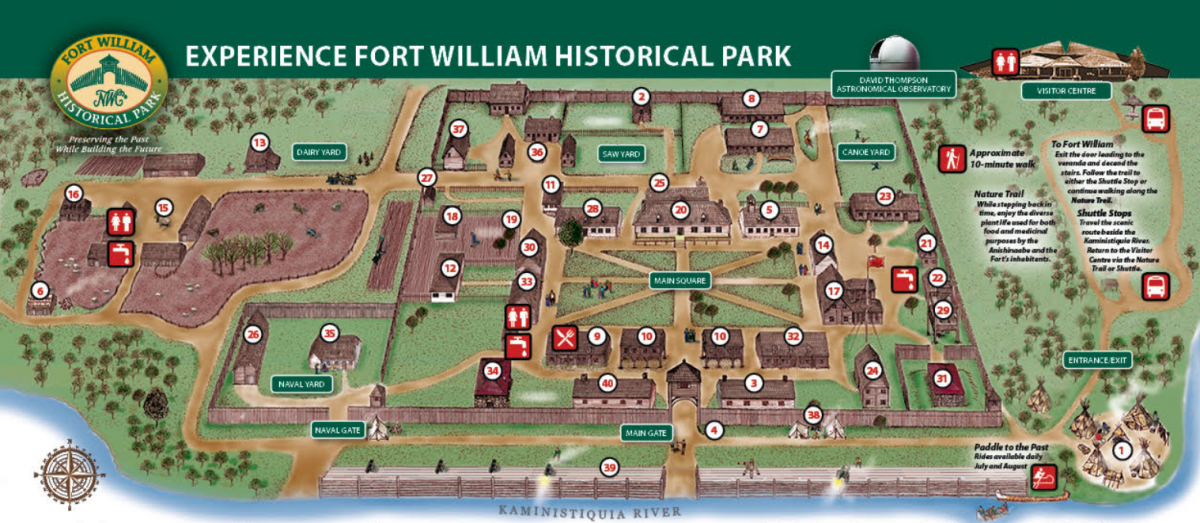
The fort is a recreation of the 1815 fort that belonged to the North West Company. The North West was the largest fur trading company in the world. As you may know, beaver hats became popular in Europe so demand for pelts was high.
We head to the Visitor Centre. Lots of grass so let Eve and Greta get their bladders empty – don’t want any peeing on the fort.
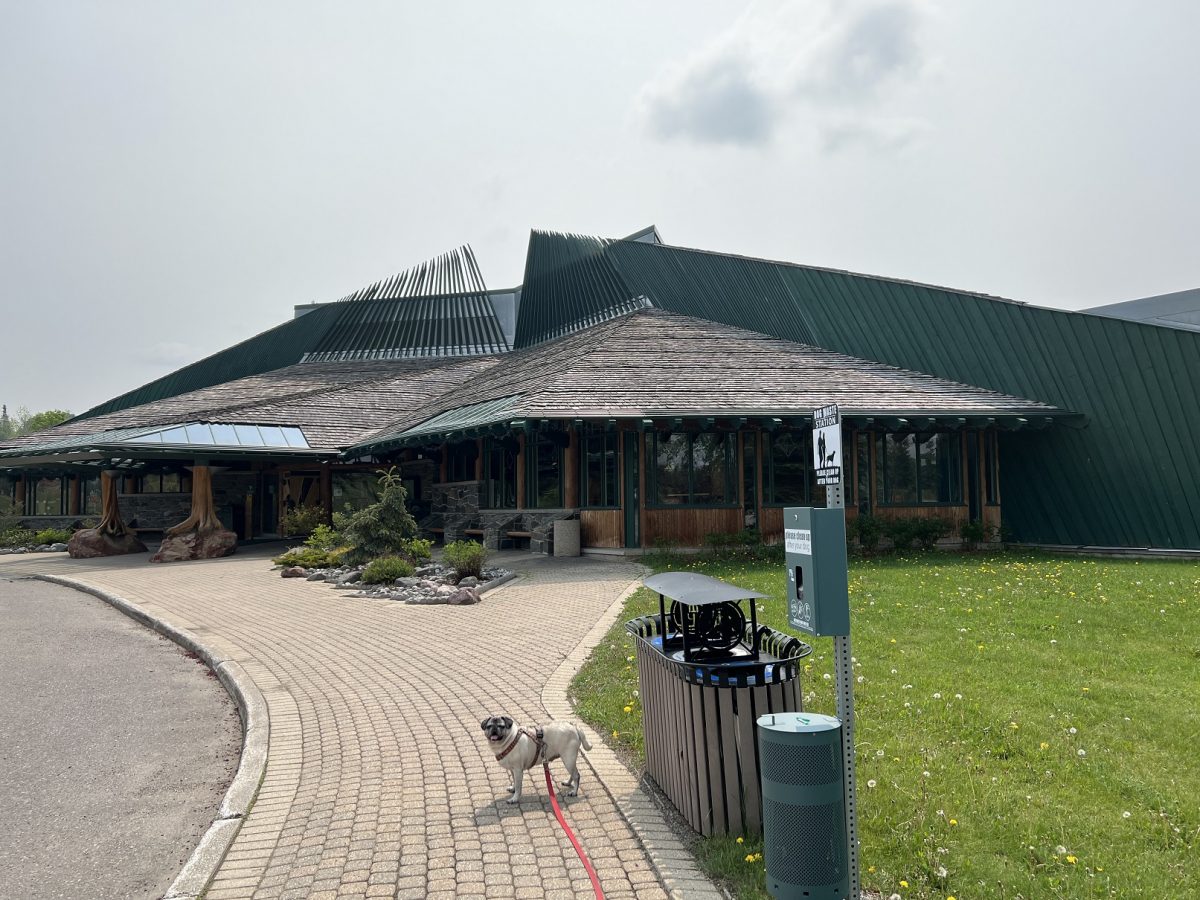
The Visitor Centre is decorated with Indigenous art and carvings. We head over to buy our admission ticket. Eve waits on the canoe bench.
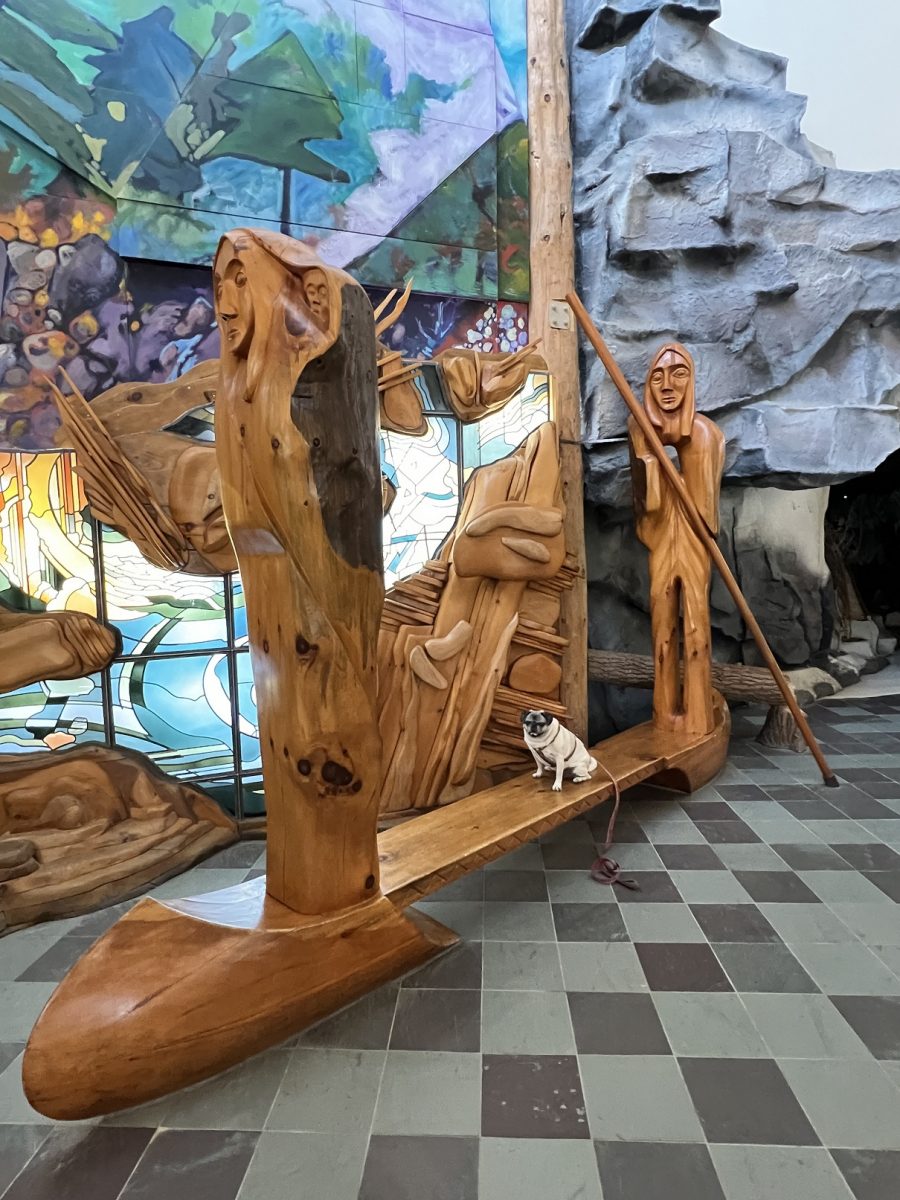
4 – Main Gate and Bastion – the guardians were able to determine who was coming and going from the fort.
Using the stroller for Greta. After spending years, isolated in a cage, she really enjoys her walks. But her arthritic knees and hips means she moves at a slow pace. I balance her time in and out of the stroller.
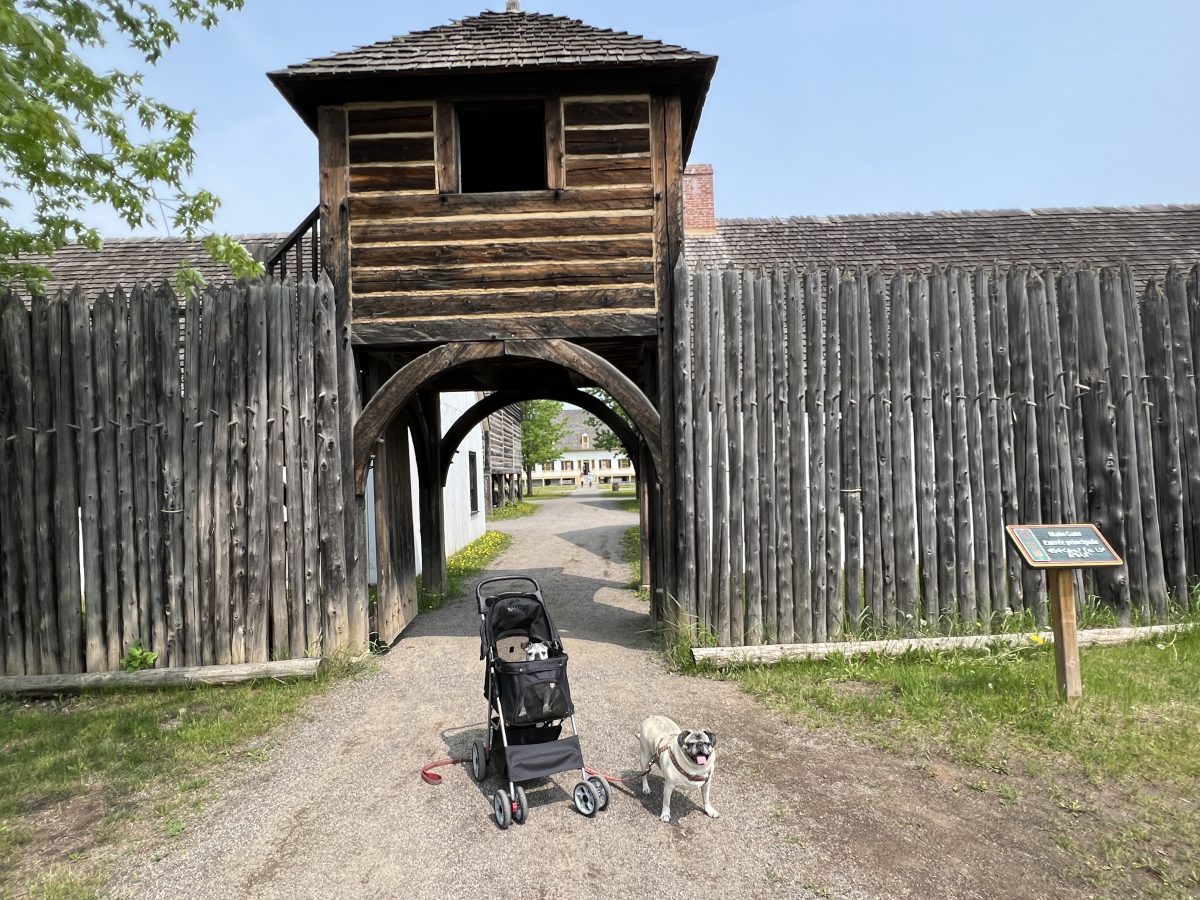
1 – Anishinaabe Encampment. Located just outside the main gate. When they came to trade, the Anishinaabe would setup their camp outside the walls of the fort. This recreation displays traditional food and handcraft making.
We stopped and I asked the woman what this place was about. She proceeded to give me a detailed explanation of what life was like for the Anishinaabe people – culture, food, tools, relationship with the fort. Artifacts were on display around the encampment.
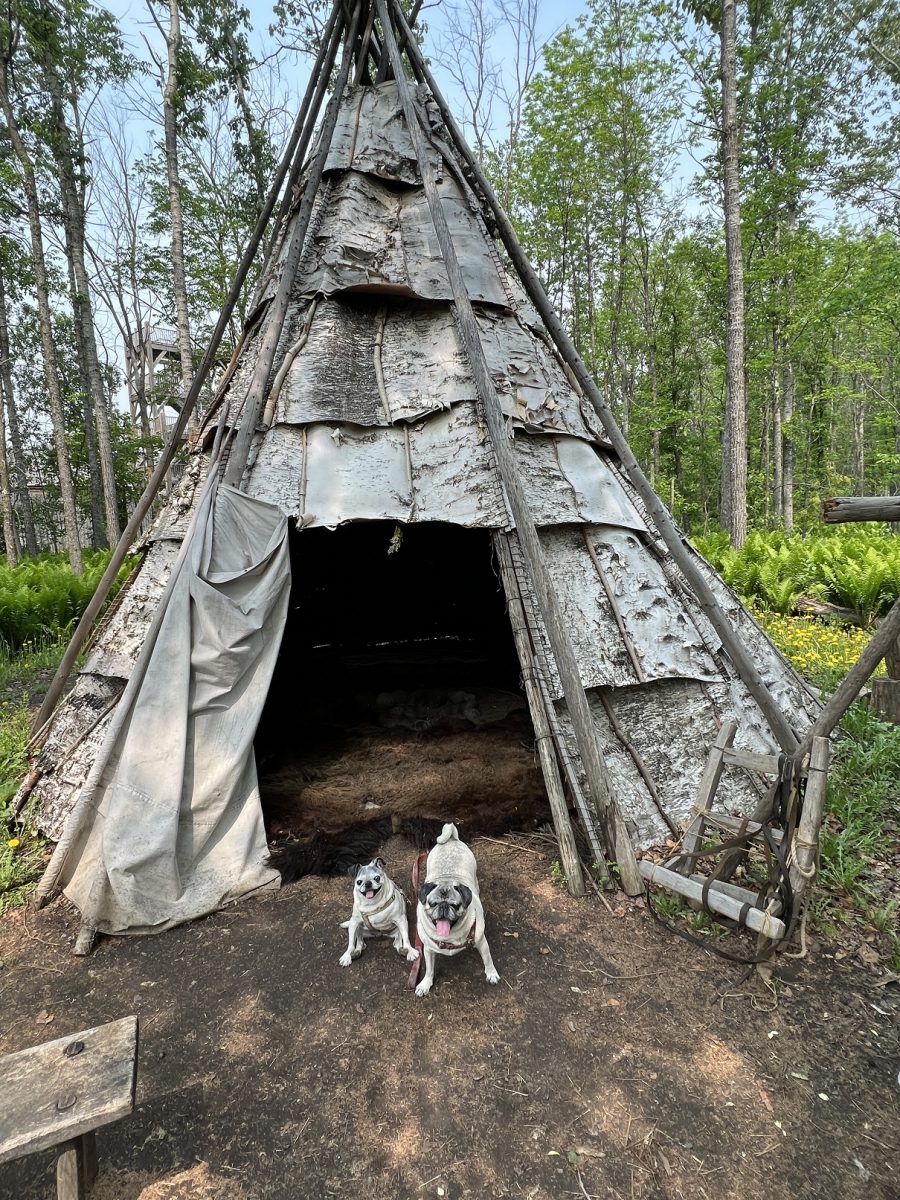
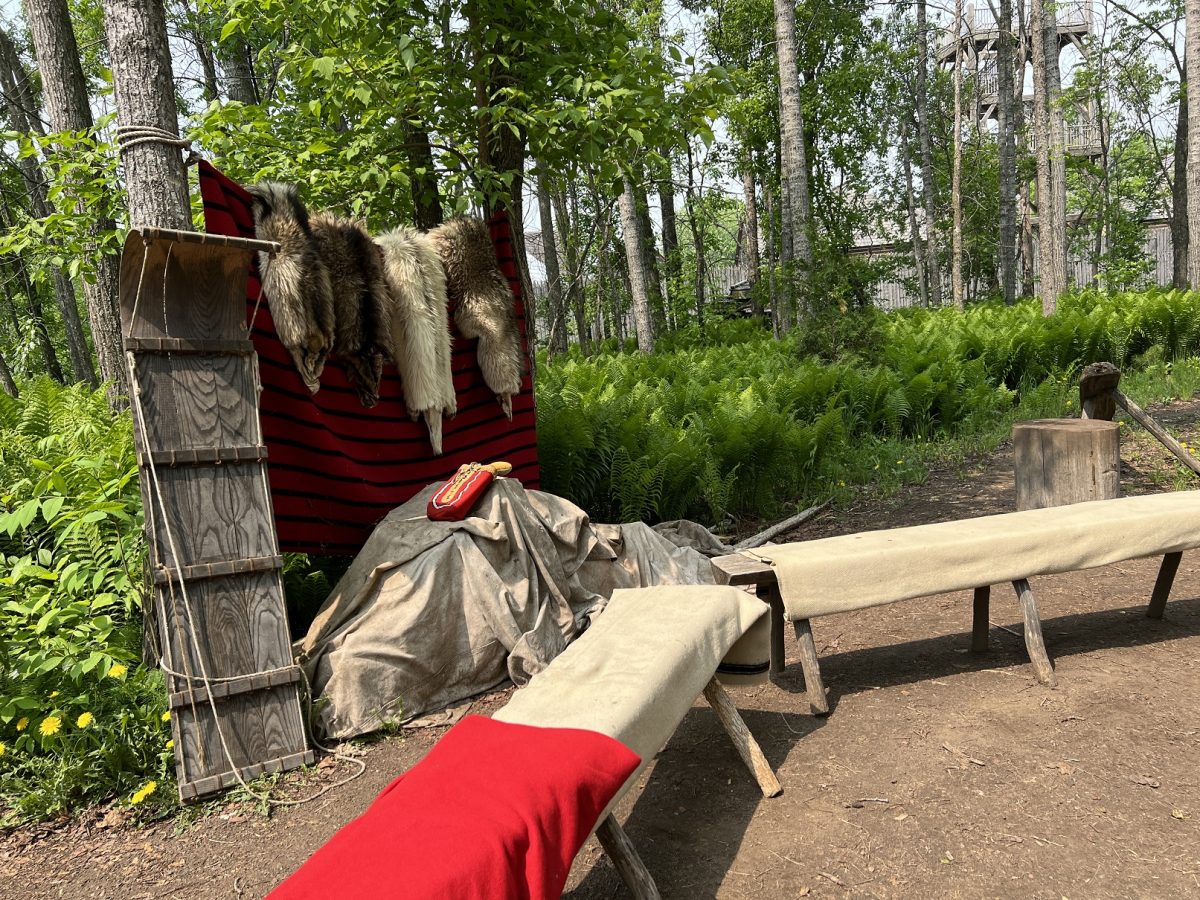
I asked her if she would hold Greta while I took a photo. Greta is usually shy of people but she really took to her. Look at the big smiles on both of them
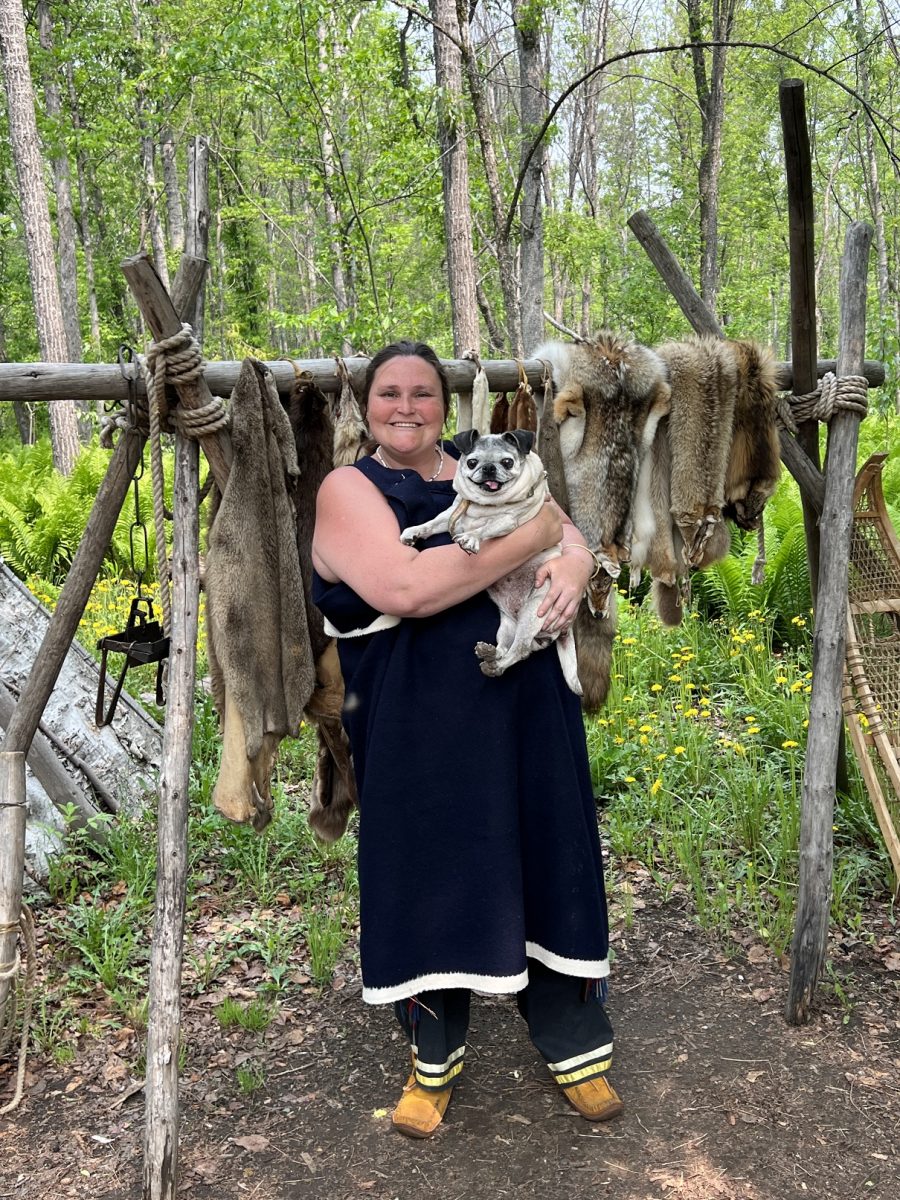
3 – Dr. John McLoughlin’s House & Apothecary. “Between the years 1803 and 1821, three doctors were posted Fort William. All of them had the dual function of surgeon and clerk – that is, they were doctors during the Rendezvous and fur traders for the rest of the year. The large apothecary area doubled as a hospital until a separate hospital was built sometime after 1811.”
Of course we could not visit everything. There is lots to see. Many of the buildings are open. You can also take a tour with a guide. But, it was getting hot. Also it was a 10 minute walk from the Visitor Centre to the fort. Had to take into account walking back.
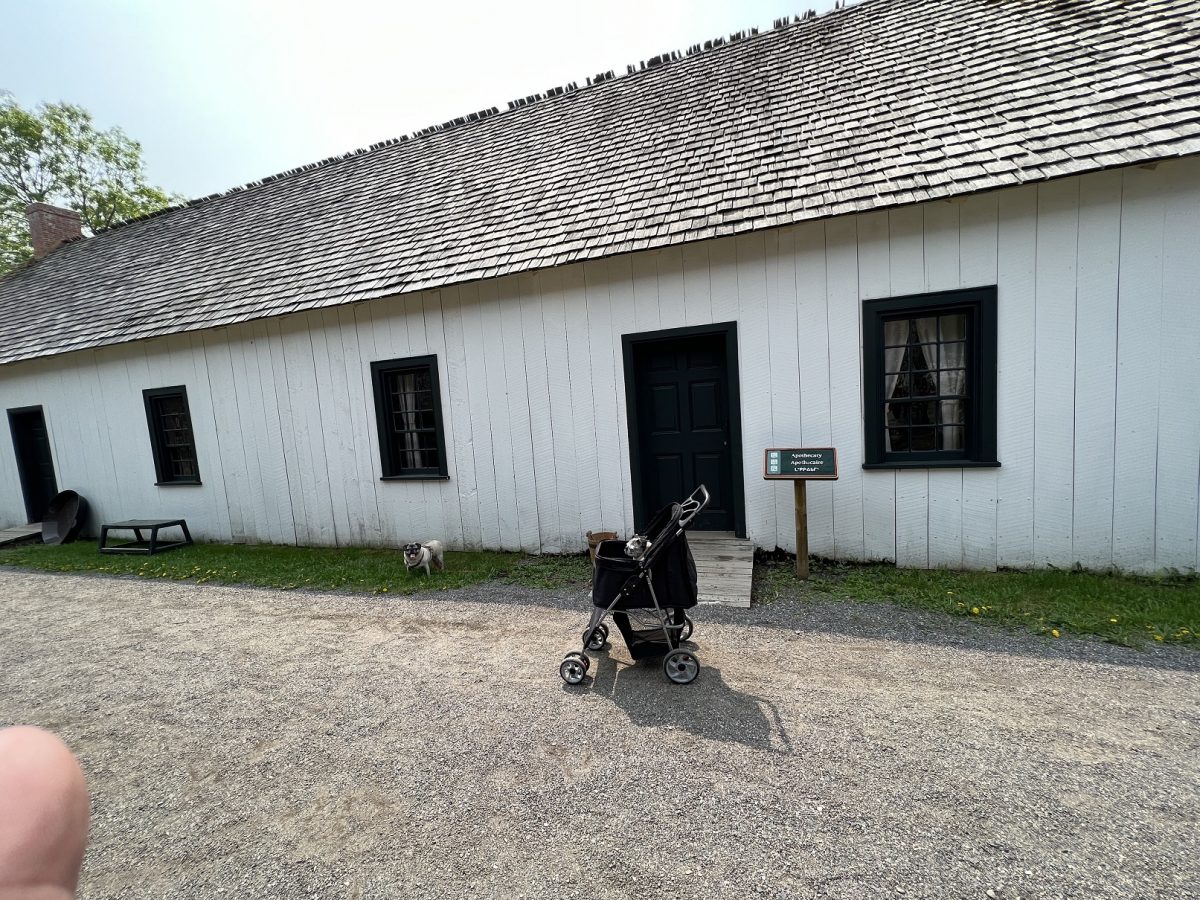
“When it came to surgery the doctor at Fort William was as well-equipped as any doctor in the Canadas. Historically, “surgery” was any medical intervention that was practised directly on the body. Although quite rarely needed, the doctor was prepared to amputate limbs or digits if necessary. The amputation of limbs during the fur trade period required a great deal of speed because anaesthetic, as we know it, was not in use, and blood loss could not be replaced with transfusions.”
24 – Indian Shop. “This was Fort William’s fur trade post, the place where the local Native trade was conducted. Like the Dry Good Stores (Shops), it was a retail outlet rather than a warehouse for goods in transit to other departments. Ojibwa and Cree from the area around Fort William came to the Fort’s Indian Shop to trade their furs, while the Company sent traders out to the Native hunting grounds in the more remote parts of the region.”

“When trading furs, the barter system was used, based on a standard of trade called the plus or plu (pronounced “plew”). Another term was “skin” meaning a prime beaver skin. (The Hudson’s Bay Company term for the same thing was “Made Beaver” or “MB”). Thus, one large blanket might be worth eight skins or plus, the equivalent of eight prime beaver. But in the actual transaction, the eight plus could be made up of a variety of furs and other products or services equal to the value of eight beavers.”
31 – Powder Magazine. “The storage of gunpowder and firearms necessitated a secure and relatively fireproof building. Thus we find the Powder Magazine of stone construction and tin roof. The building is so constructed that the thick stone walls channel the force of an explosion upward. This would lift the roof off the stone walls it sits on. Thus limiting the side ways force of the explosion. The lower sides are further enforced with earth to catch some of the stone from the wall. The building is further secured with its own palisade and lockable gate.”
Photo op for Greta and a chance for her to walk around the Powder Magazine.
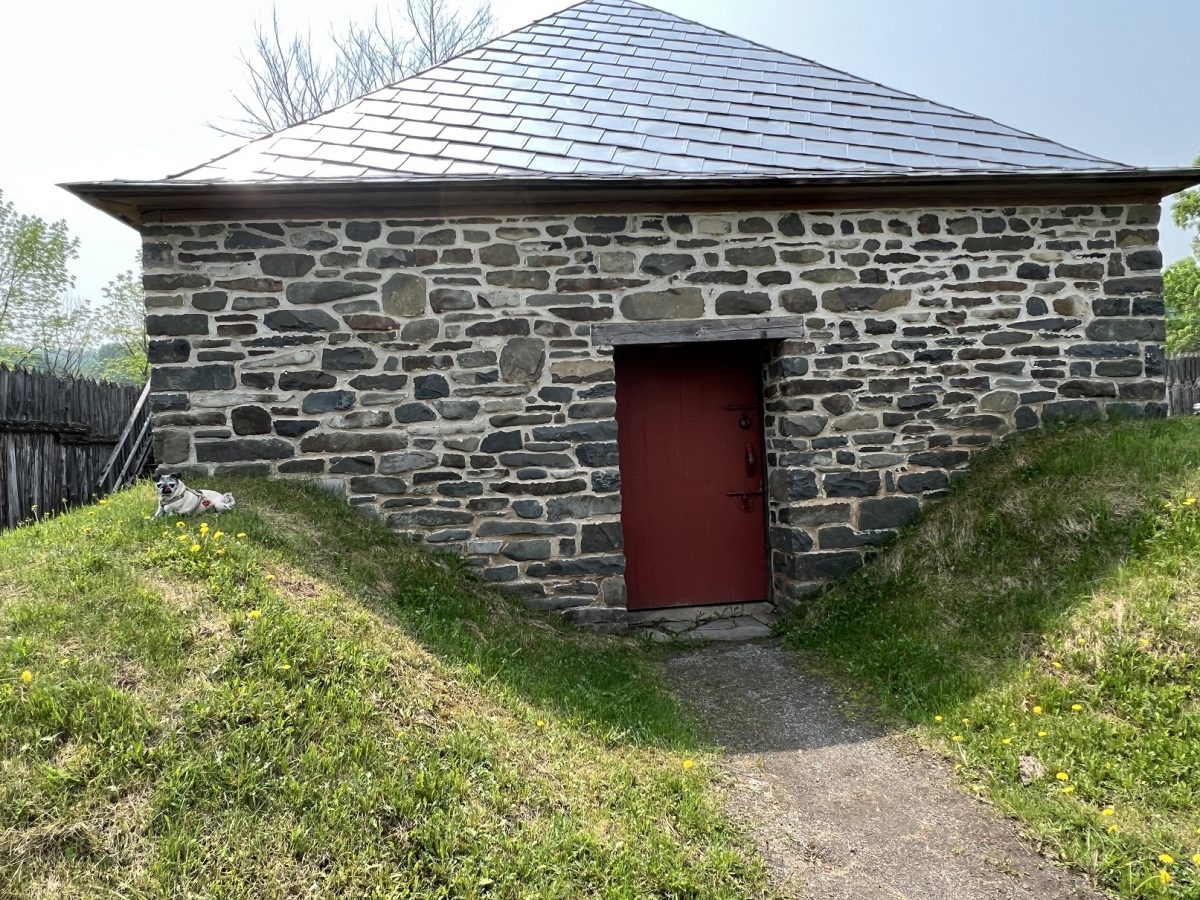
The Guard Tower in the background.
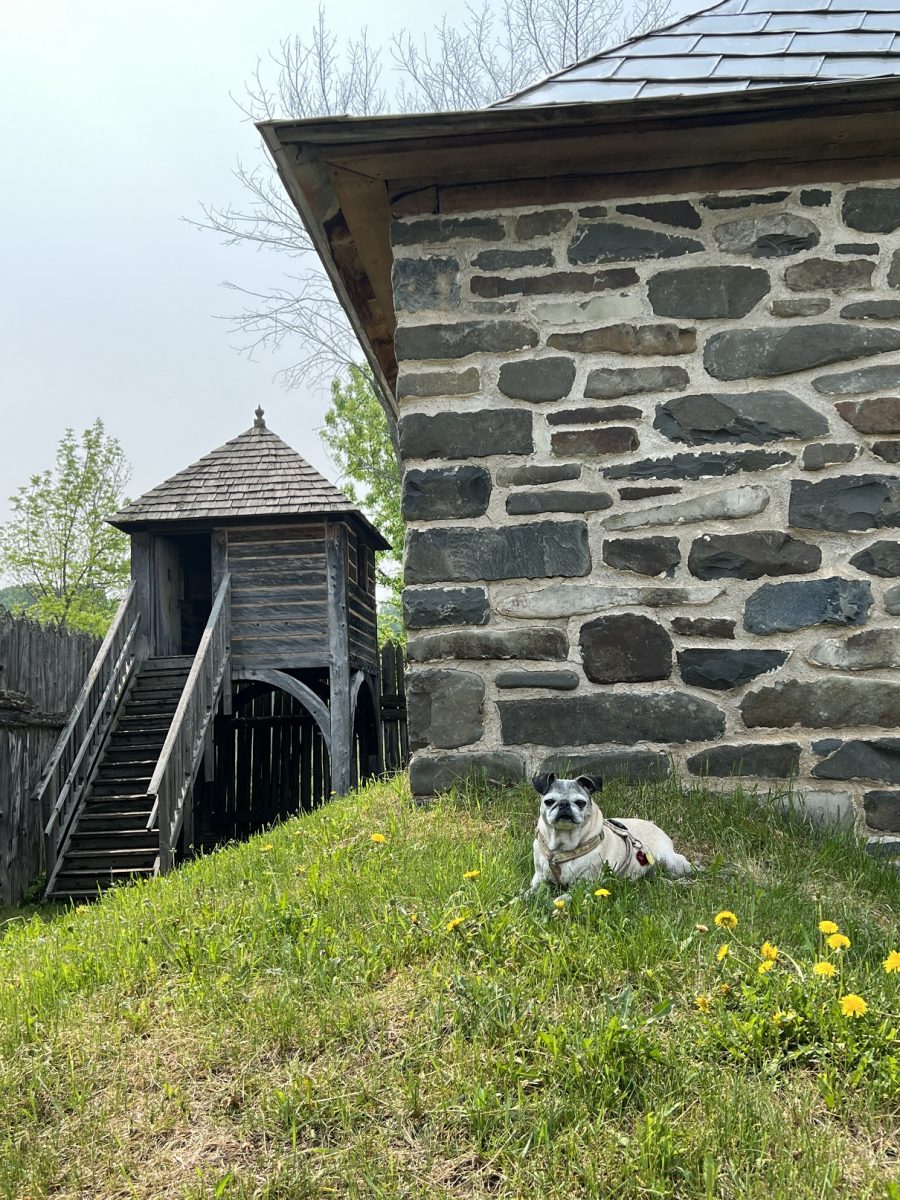
“From 1818 to 1821, military equipment is listed in the inventories under the heading “Armoury”. Included in 1820 were 48 new English and 59 American muskets complete with cartridge boxes and bayonets, 13 iron guns, 8 brass field pieces, 3 blunderbusses, 2 wall pieces, 57 fusils, 173 Kegs of gunpowder and 80 pistols.”
“There has been much conjecture about the Armoury and the reasons for this array of arms at Fort William. Even before the Selkirk affair, Fort William had “carriage” guns and muskets with bayonets. In 1812 some of these equipments including men and local native warriors were sent to Sault Ste. Marie to assist in preparations for the British attack on the U.S. base at Michilimackinac. Whether more arms came to Fort William as a result of the War of 1812 is not clear.”
21 – Guides House. At the Rendezvous, the guides and interpreters were the only voyageurs allowed to live inside the palisade. This building was reserved for them because of their seniority and importance in the transportation system. They also had the privilege of eating in the Great Hall along with the gentlemen.
The fort will be having an event called Great Rendezvous in July. Celtic Days, Farm and Food, Art and Music will be some of the happenings. There are both volunteers and paid employees who help visitors understand what life was like.
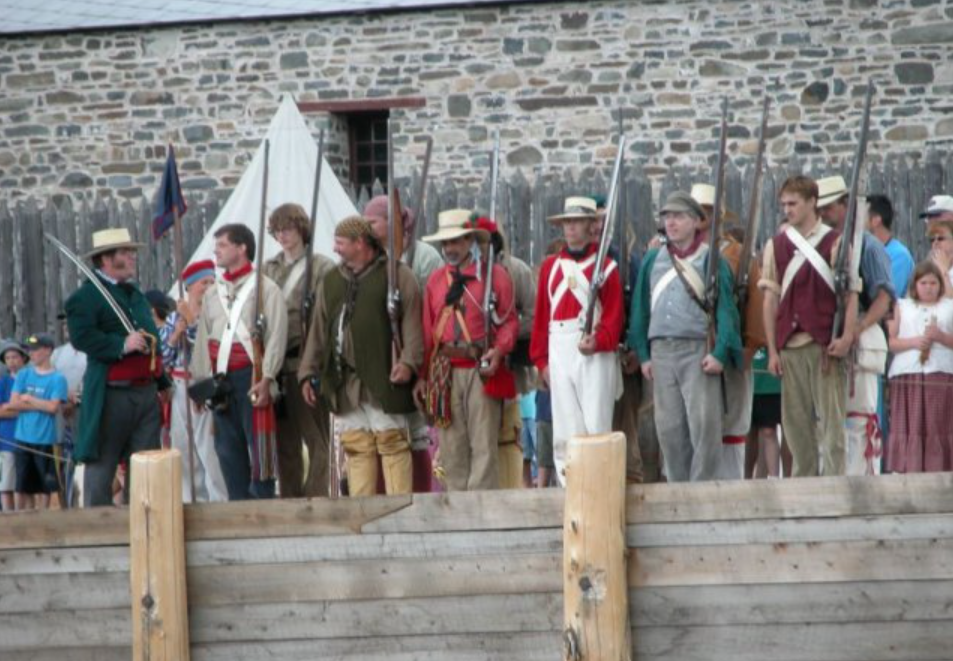
The Guides House was one of the buildings that was open so we went in to explore.
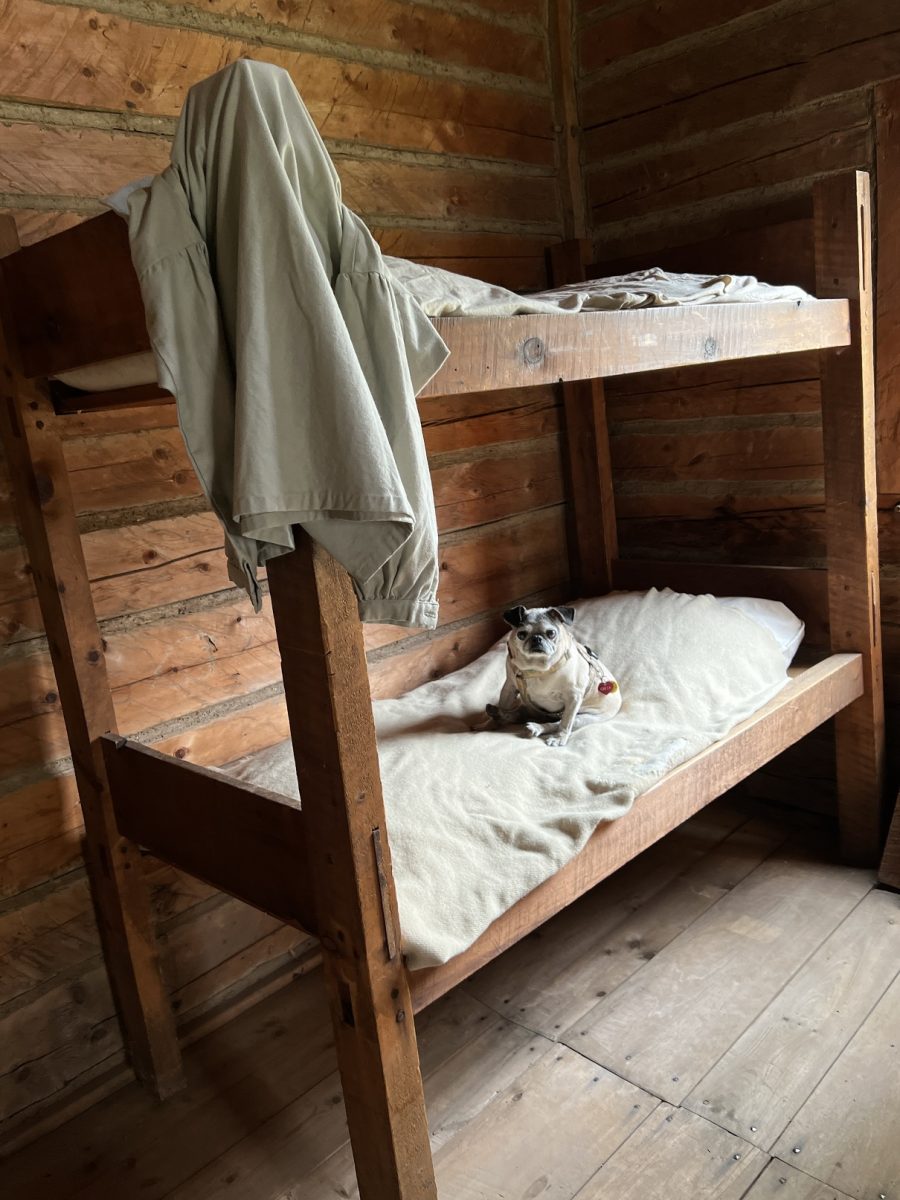
“The voyageurs on the whole were an ostentatious lot. The higher up the social ladder the more flamboyant their clothing. Reflecting this cultural trait are the colourful items of dress displayed in the Guides’ House, including the beaver felt top hat decorated with coloured plumes.”
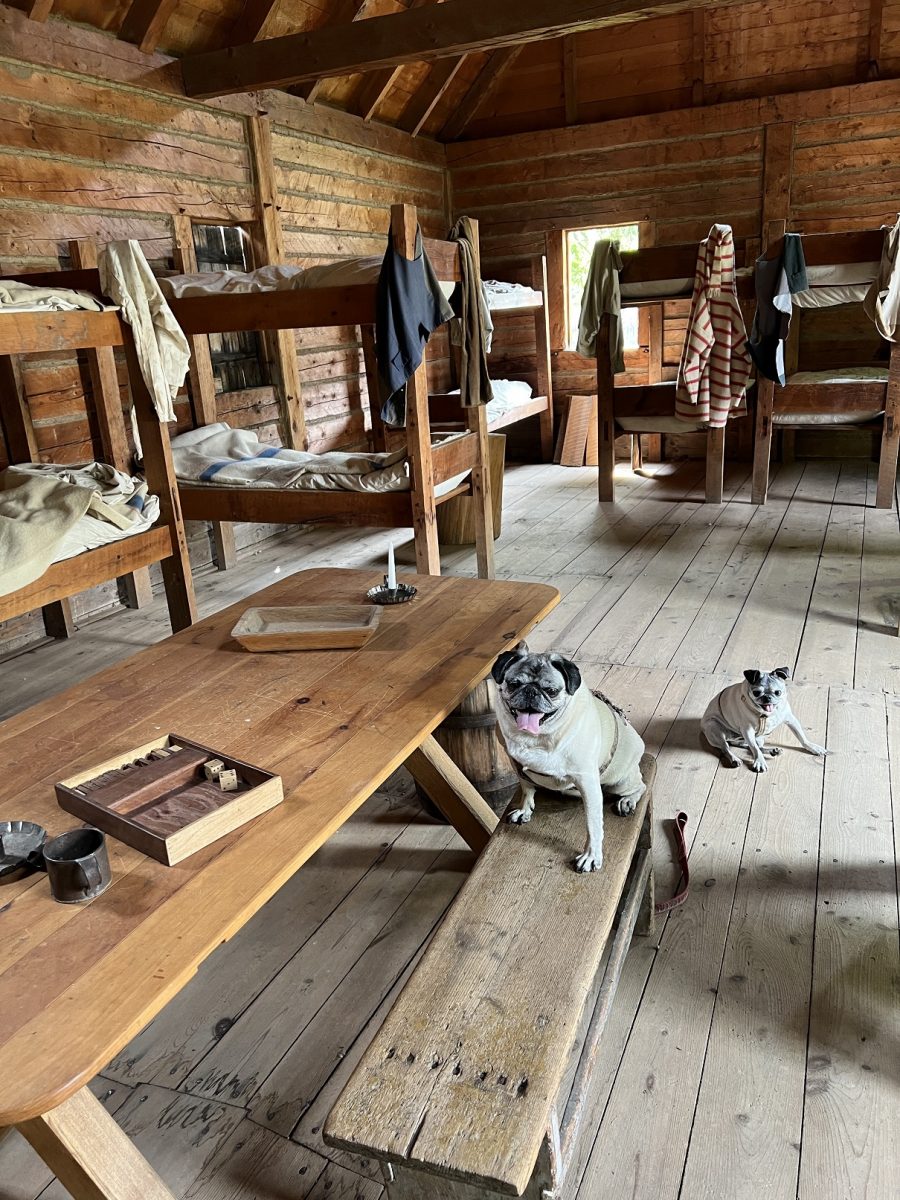
23 – Hospital. “The importance attached to health care by the North West Company can be seen in the existence of two buildings for this purpose. Up to 1811 at least, the Doctor’s House and Apothecary was probably the only place used for medical treatment. By 1816 a separate hospital had been built, as Selkirk’s Plan shows. In addition, the North West Company always had a doctor stationed at Fort William during the summer months.”
I think Eve wanted to take home the bear rug.
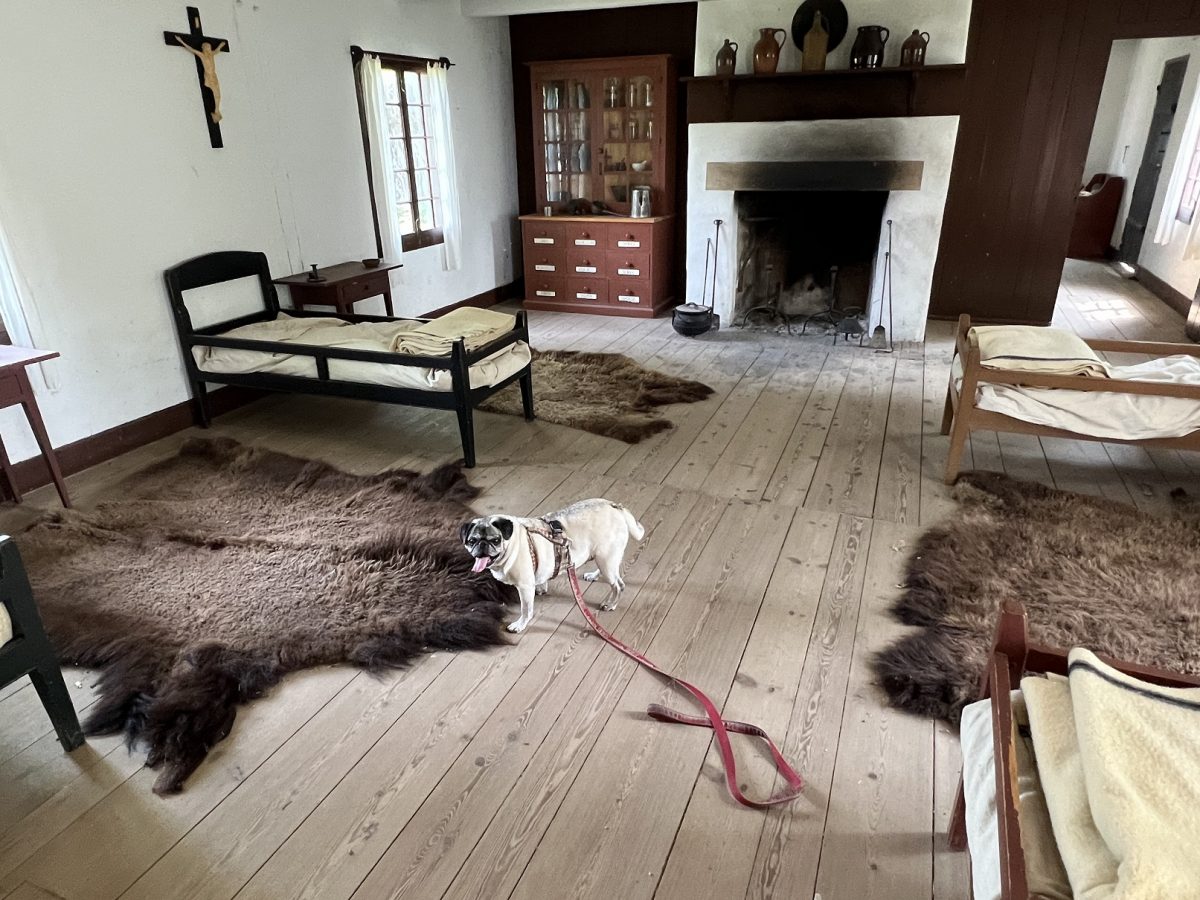
7 – Canoe Shed. “The most common and practical method of inland water transportation during the fur trade was the birch bark canoe. Created, developed and crafted by the North American aboriginals from readily available materials from the Canadian Shield, the canoe was quickly adopted by Europeans as the most practical method of transportation into the interior of North America to meet the needs of commerce and exploration. The Native design and construction was much better suited to the smaller and more rugged waterways of North America than the larger wooden vessels developed in Europe. The light easily portaged canoe could be carried by the crew and was able to carry a huge load relative to the weight of the craft.”
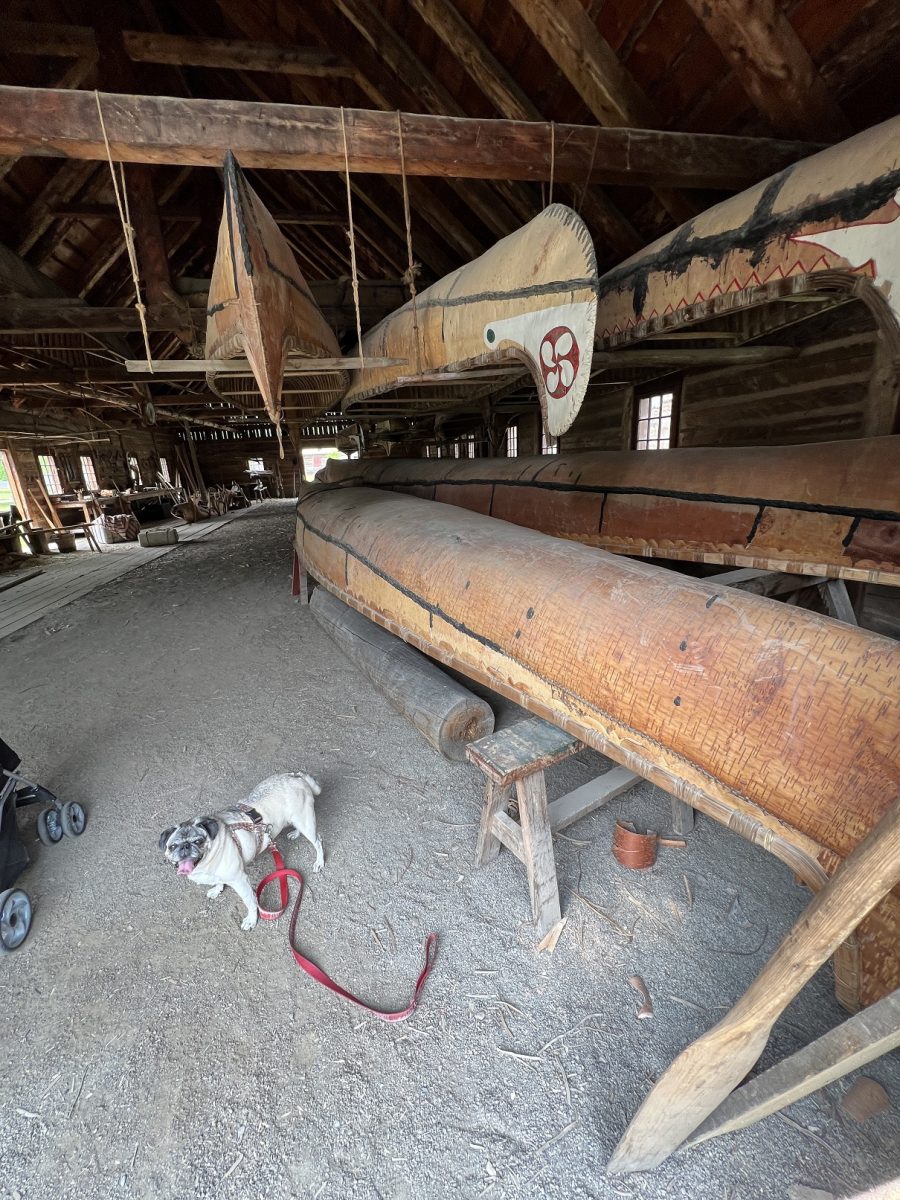
“Although voyageurs repaired them frequently while travelling, the life expectancy of a fur trade canoe was short. Because of this, the North West Company established canoe building and repair centres at key locations, at Fort William and Rainy Lake were two places the canoes were being built. The materials for birch bark canoe construction were gathered from the forest in the region and were often traded to the Company by the Native’s. The bark from the white birch tree was harvested in large sheets that were sewn together with watape (the peeled root of the spruce tree) to form the outer shell, and also wood for thwarts (crossbars) and doweling. Eastern White Cedar logs were split into straight grained, light and easily worked wood for ribs, sheathing, gunwales and stems. Spruce furnished watape (roots) for sewing and binding, and also gum that made seams waterproof when tempered with animal fat.”
25 – Kitchen & Bakery. “The dominant feature of the Bakery was the huge bake-oven. In it, enormous quantities of bread were baked, not only for serving in the Great Hall but also at the “Cantine”, where voyageurs were treated to a loaf of bread on arrival at Fort William. Bread and biscuit were also prepared for the return voyage to Montreal or the interior.”
“Some idea of the productive capacity of the bake-oven may be had from the figures for 1821. From June 16 to August 9, over twenty thousand pounds (9000 kg) of flour were used to produce bread and biscuit.”
The Cantina Restaurant is located in this building. They have an outdoor patio and I had decided that I would have lunch here. The patio was shaded so gave time for Eve to relax. We would be heading to the hotel after lunch.
20 – Great Hall. “Here the Company proprietary-agents, partners and clerks-dined together. Joining them were the guides and interpreters, the only personnel below the rank of “gentleman” allowed to eat in the hall. Seating arrangements reflected the hierarchical structure within the Company.”
“The hall was also the location for special occasions and celebrations. Balls in which the gentlemen danced with the “ladies of the country” to the tune of bag-pipe, violin, flute and the fife took place in the Great Hall, as did ceremonies where presents were exchanged between Natives and company directors.”
“In charge of the pantry and all the arrangements for serving food was a butler or maître d’hôtel who came from Montreal each season. When one considers that the butler was paid fifty to sixty pounds for the summer (compared to twenty pounds for an apprentice clerk for a whole year), one can appreciate the emphasis given to properly served meals in a properly appointed dining room.”
9 – Cantina Restaurant. Historically this was the depot for liquor and foodstuffs. They have a pet friendly outdoor patio so we stopped here for lunch. The only problems were the mosquitoes and the slow service. It wasn’t busy but my Shepherd’s pie to a long time to prepare. Then the waiter forgot my cutlery. Waited and waited and went inside to find him. He finally came out the side door with another order. Saw me staring at him. He put down the plates, went back to get my cutlery and apologized. Meanwhile I’ve been swatting away. Ate quickly then left.
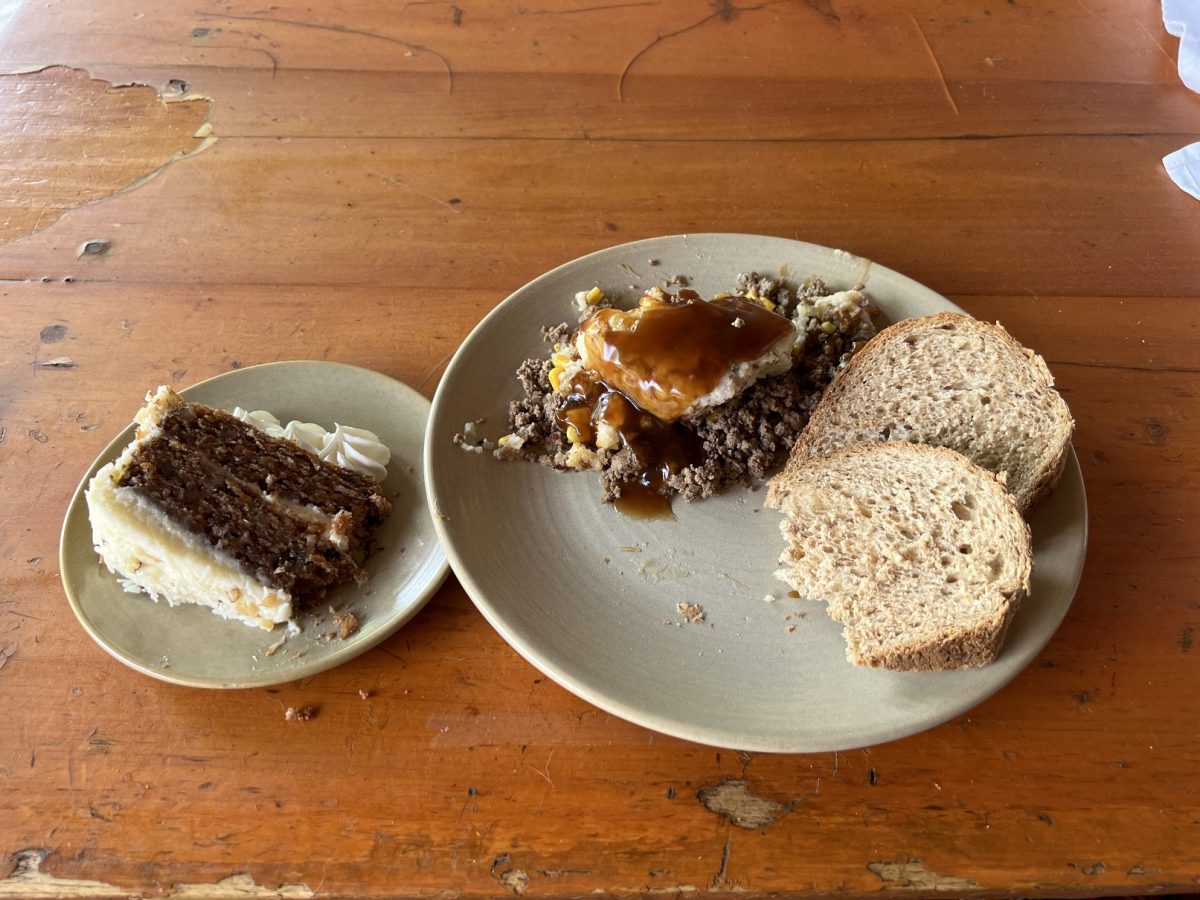
Ramada By Wyndham. The hotel is located near the airport. I wanted to get an early start so chose this hotel instead of one downtown. It’s a Monday night so there isn’t much happening on the music scene. They didn’t have my scheduled room but she went and talked with the cleaning staff. Came back with a room for me. The pet friendly rooms have a door to the outside which leads to a grassy area. How thoughtful.
The pugs ate then I put Greta on the dog bed. Eve laid down on the carpet next to her. I was going to take them on the art tour but decided they had had enough.
Public Art Tour. The Thunder Bay tourism office offered a self guided tour of some of the public art installations along the waterfront. I’ve come to really enjoy the outdoor, public art.
Drove down to Waterfront Plaza – which is Thunder Bay’s renovated waterfront walkway. A cool breeze was coming off of Lake Superior. There are lots of activities – splash pad, water garden, skateboard park. It really is well done.
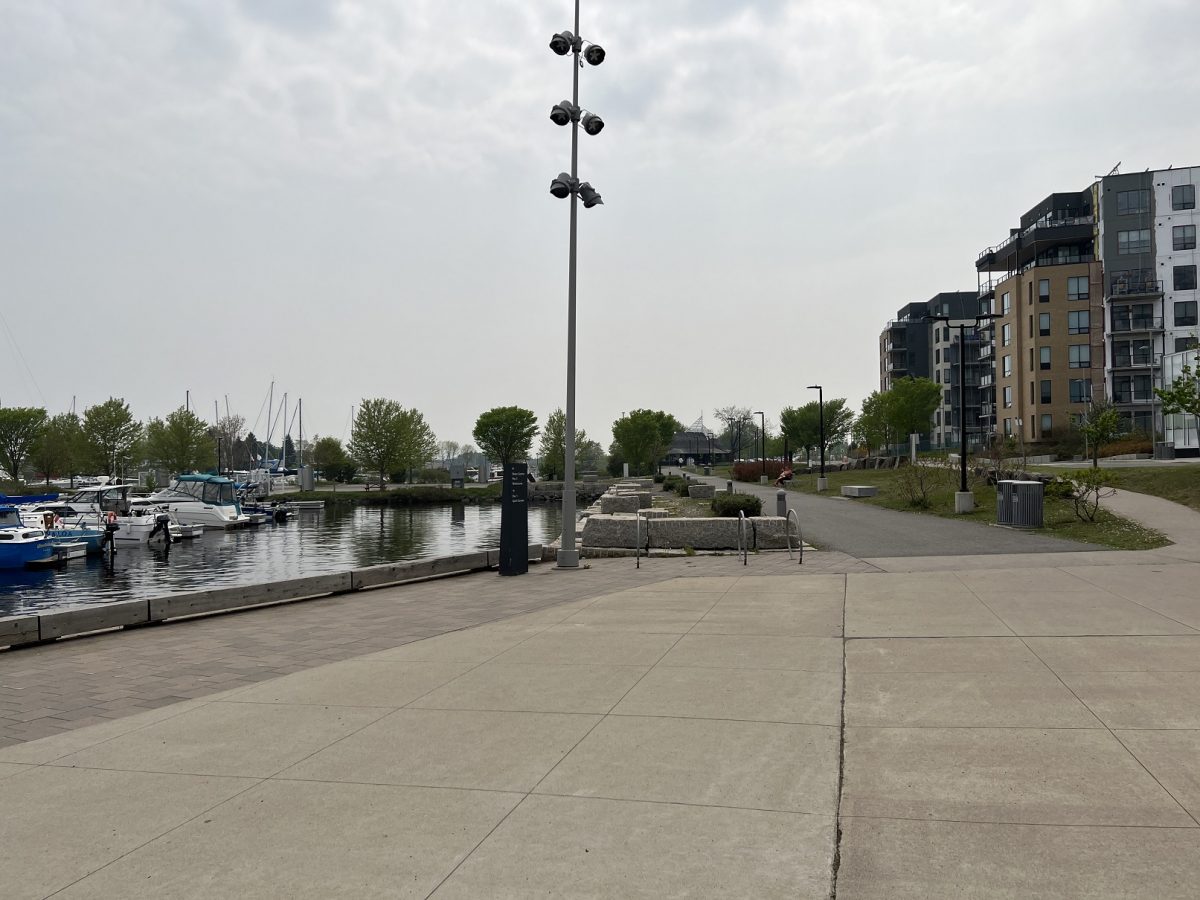
I had downloaded a map of the Public Art Walking Tour. A couple of the installations were no longer there but did give me a chance to get my daily steps in.
Celebration Circle Panels
RANDY THOMAS & ROY THOMAS
“A series of art panels adorn the face of the Celebration Circle in the Spirit Garden. Images of animals, representing air, land, water and fire, are portrayed in the Woodland style of art developed by the Ojibwe people. Each panel references the artist’s Ahnisnabae culture, including images of Turtle Island (North America) and the Thunderbird.”
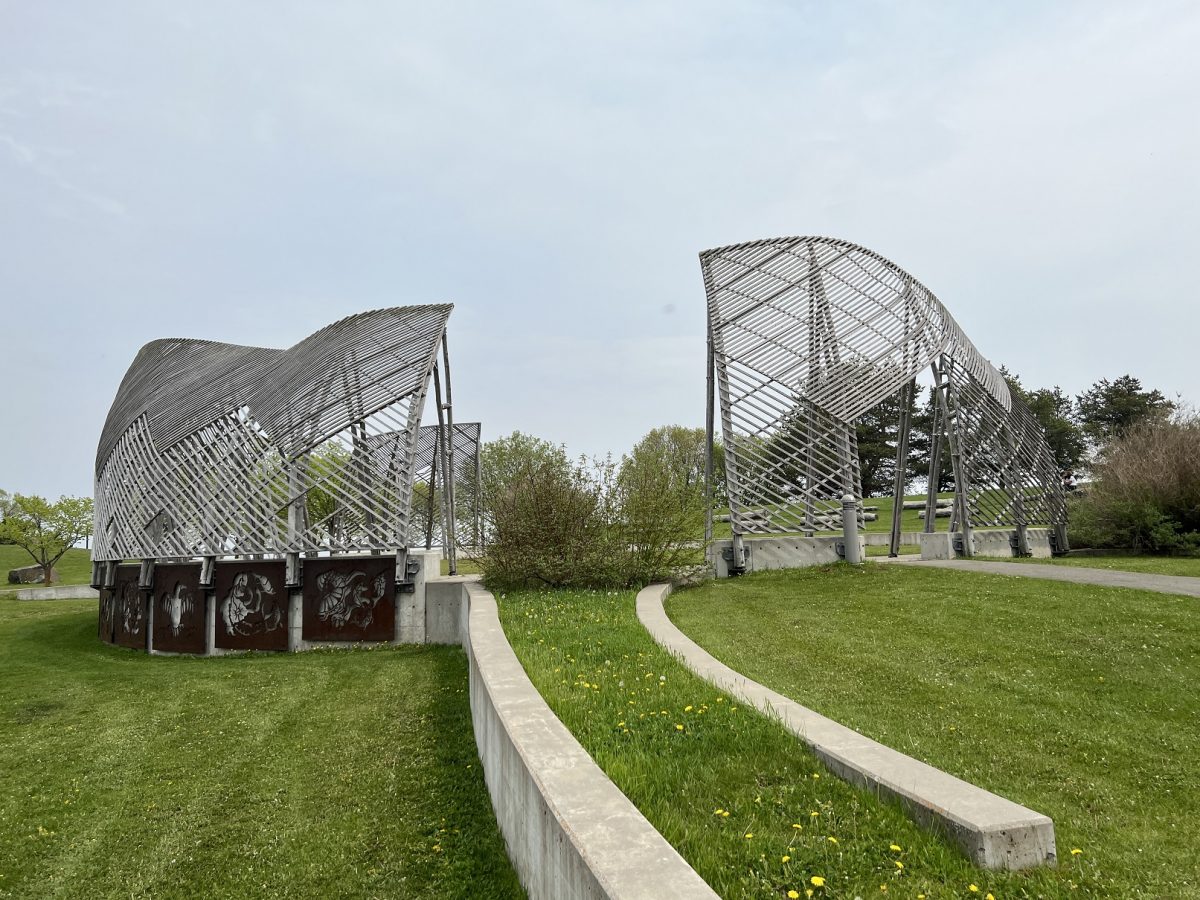
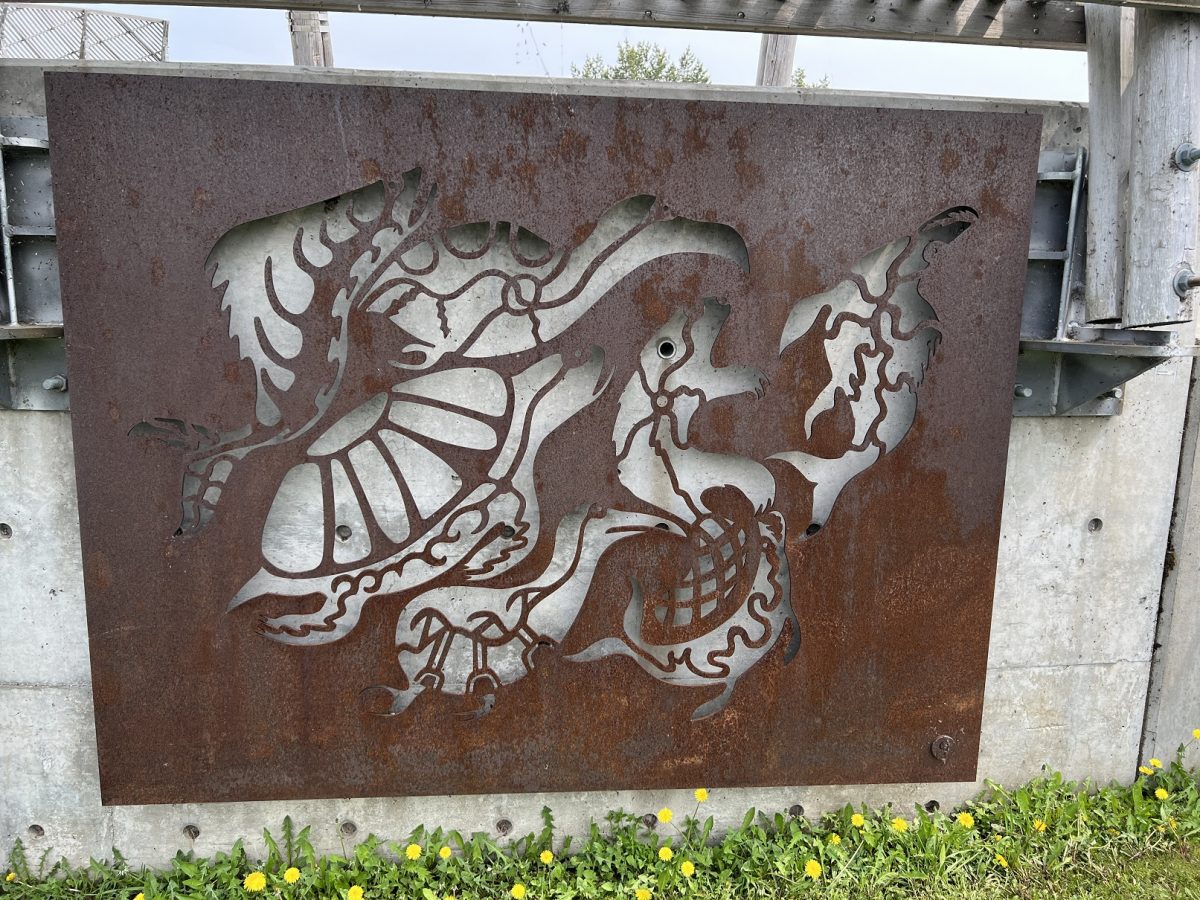
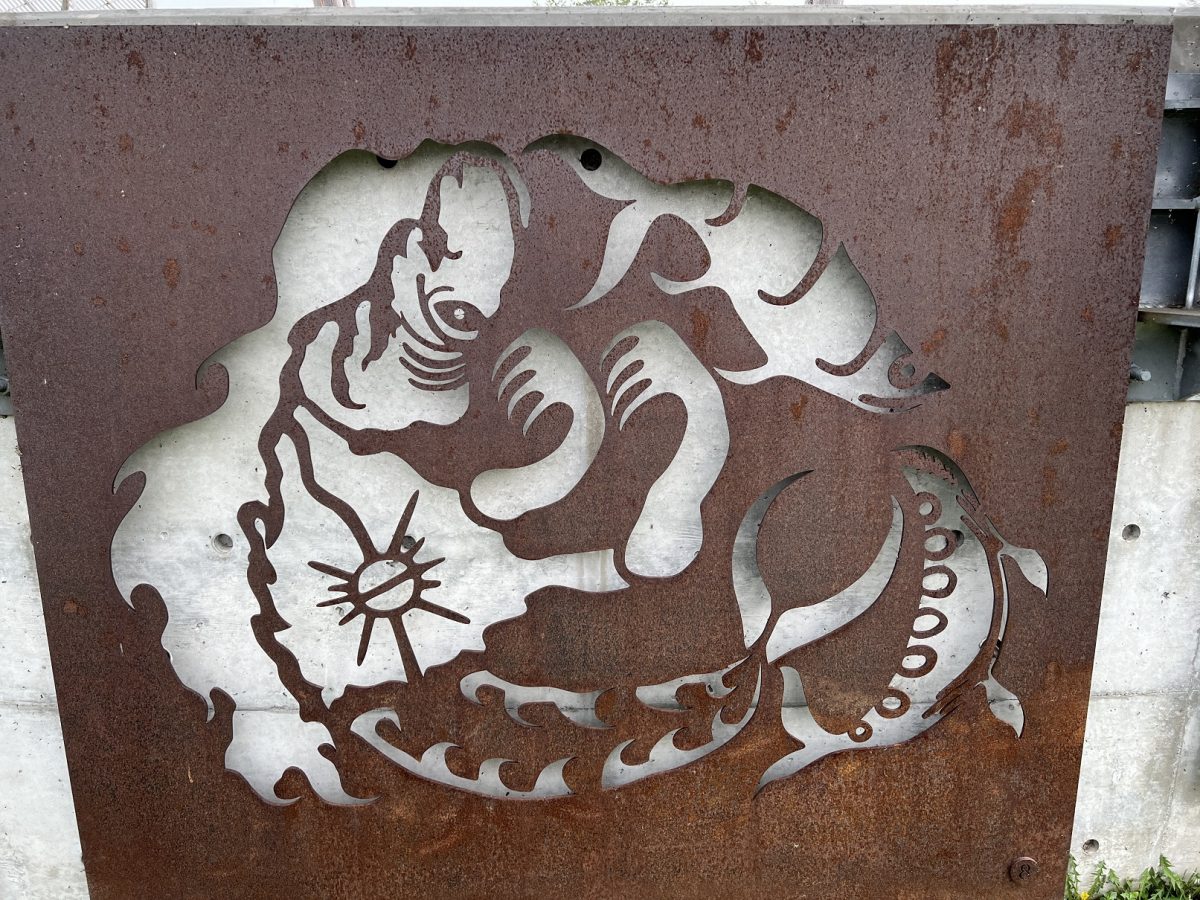
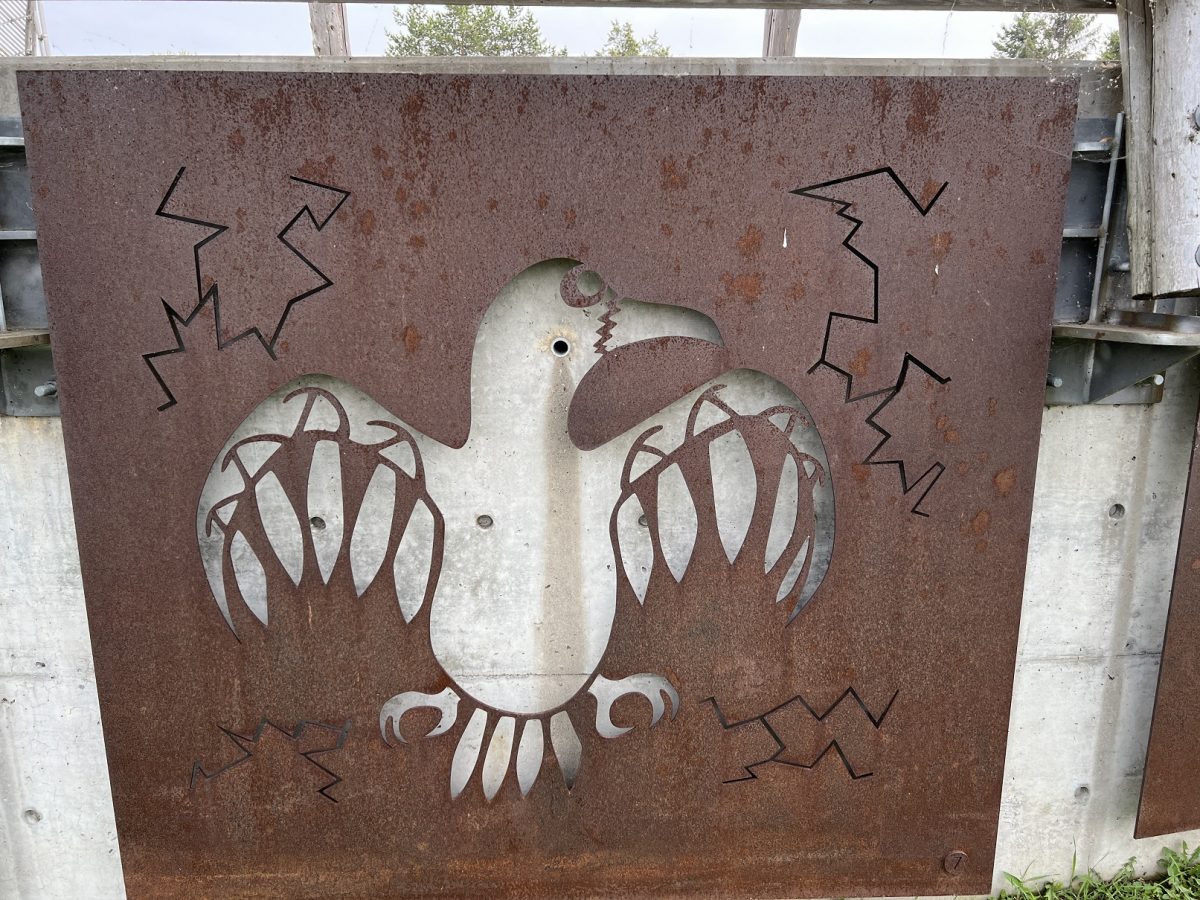
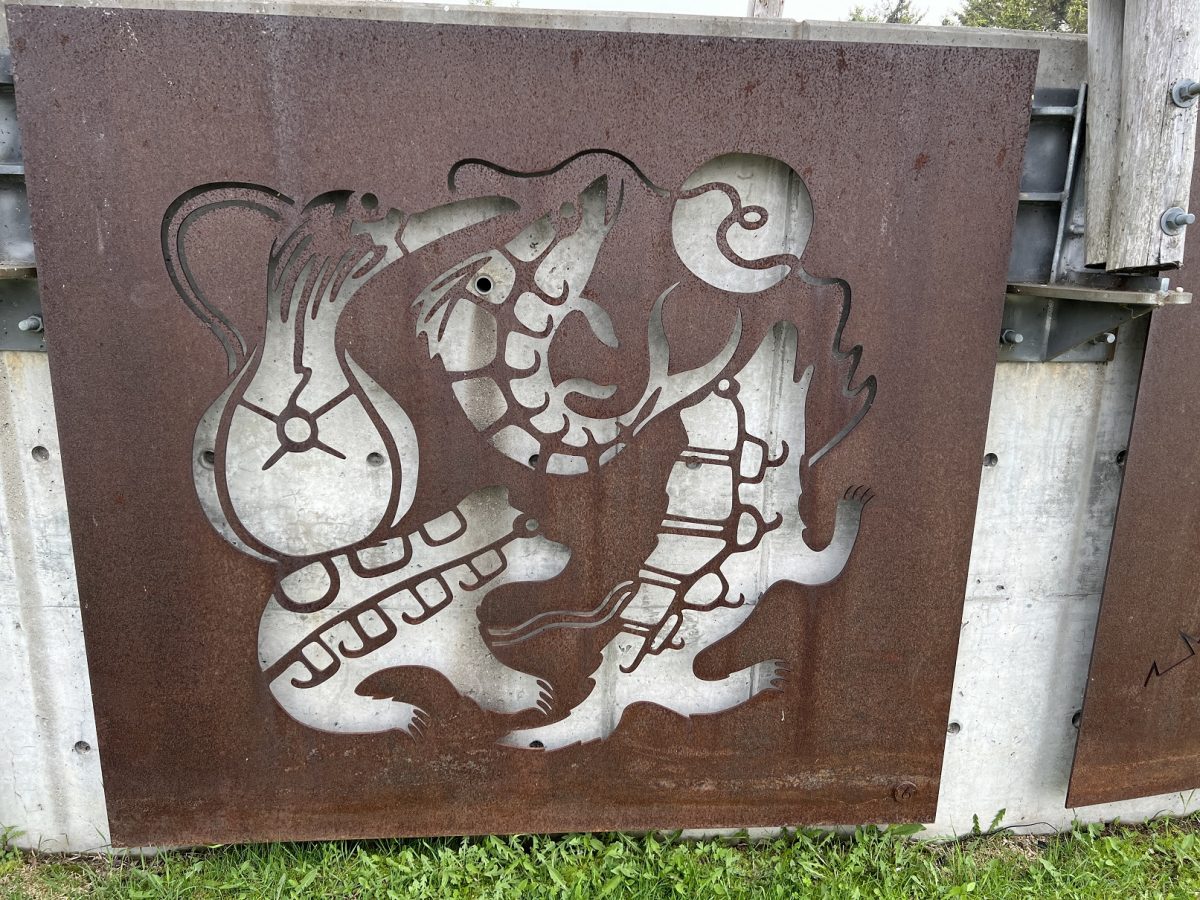
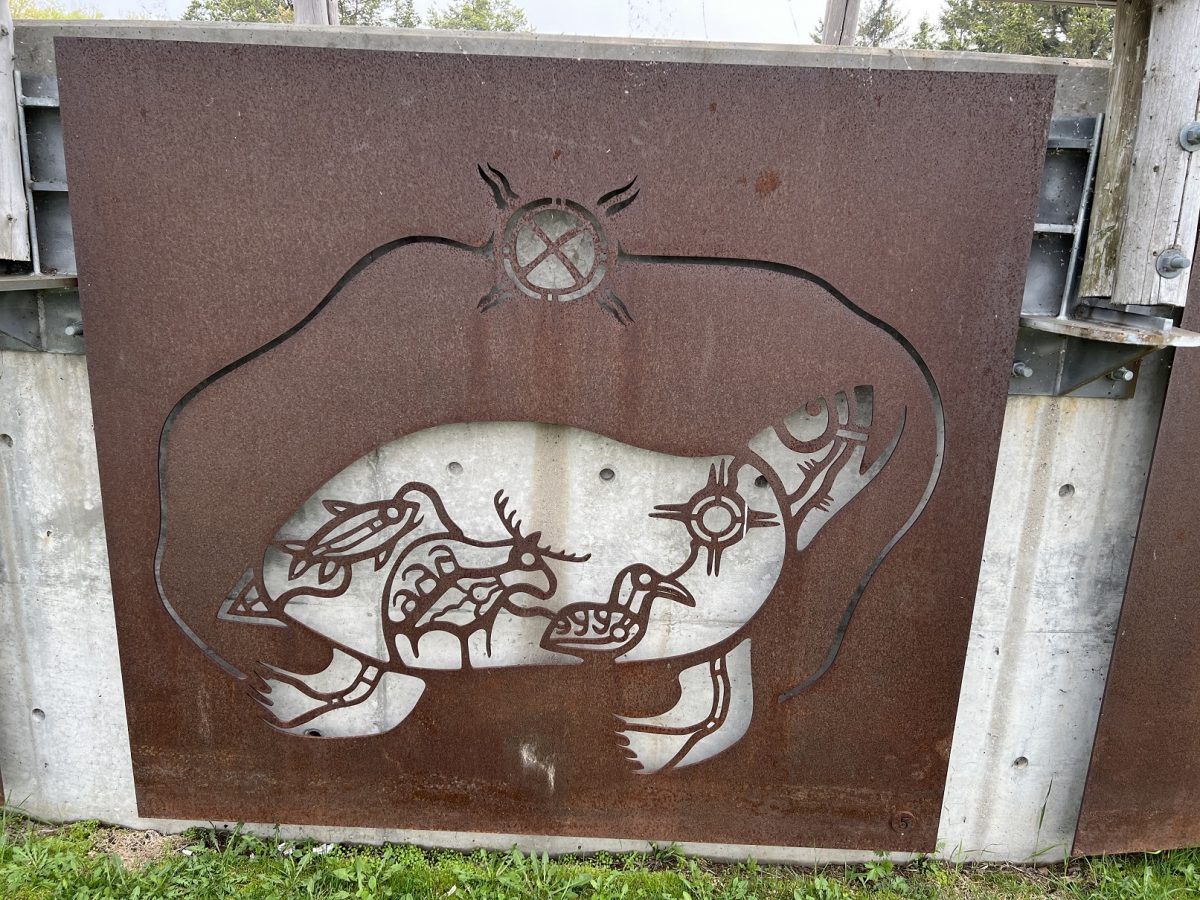
Lanterns – Paleogirls, Swimmers, Ulysses
MARK NISENHOLT
“Three cedar lanterns on Pier 2 feature vibrant, colourful artwork on their glass front panels. The digital imagery depicts ‘giant’ figures and explores the theme of Man’s relationship to the water and to nature, eliciting responses that are compatible with the vast spaces and contemplative state of mind that the lake shore embodies.”
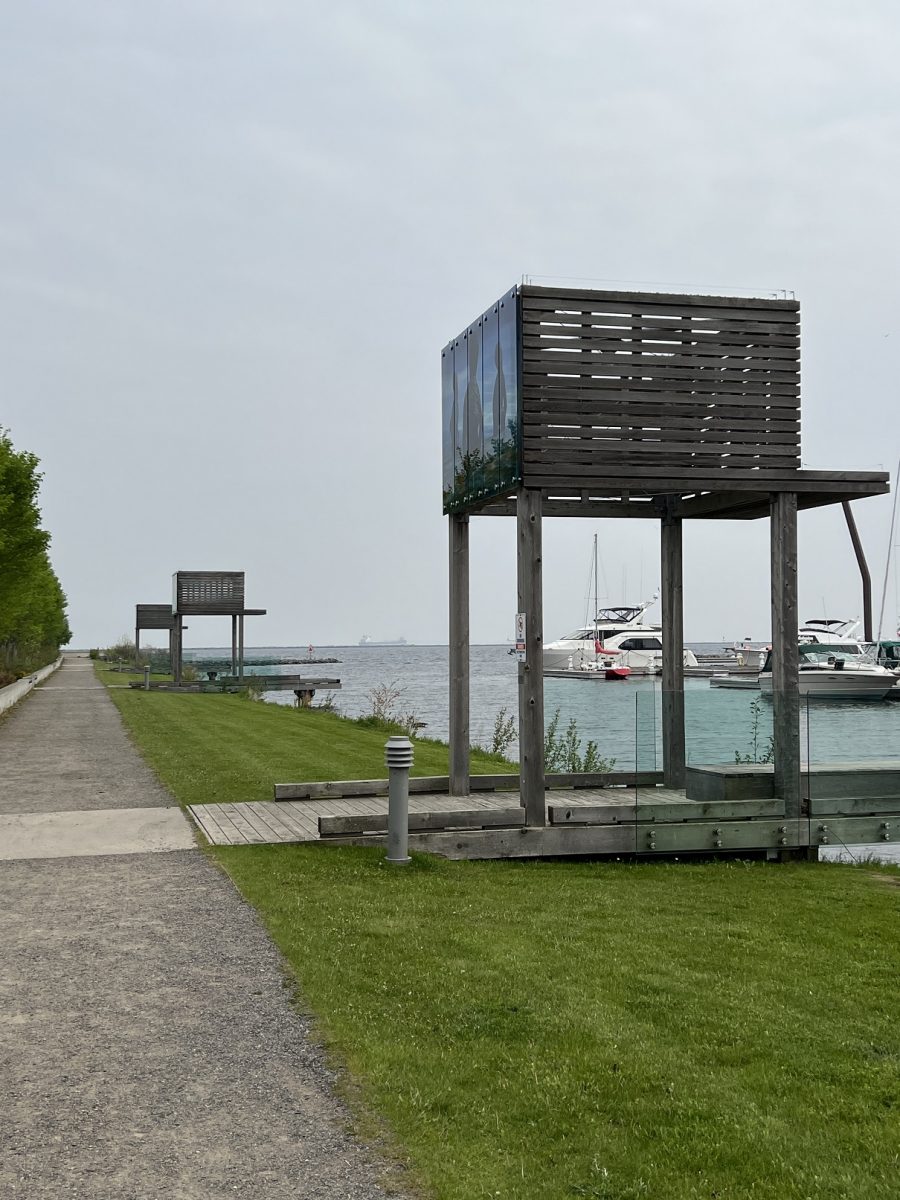
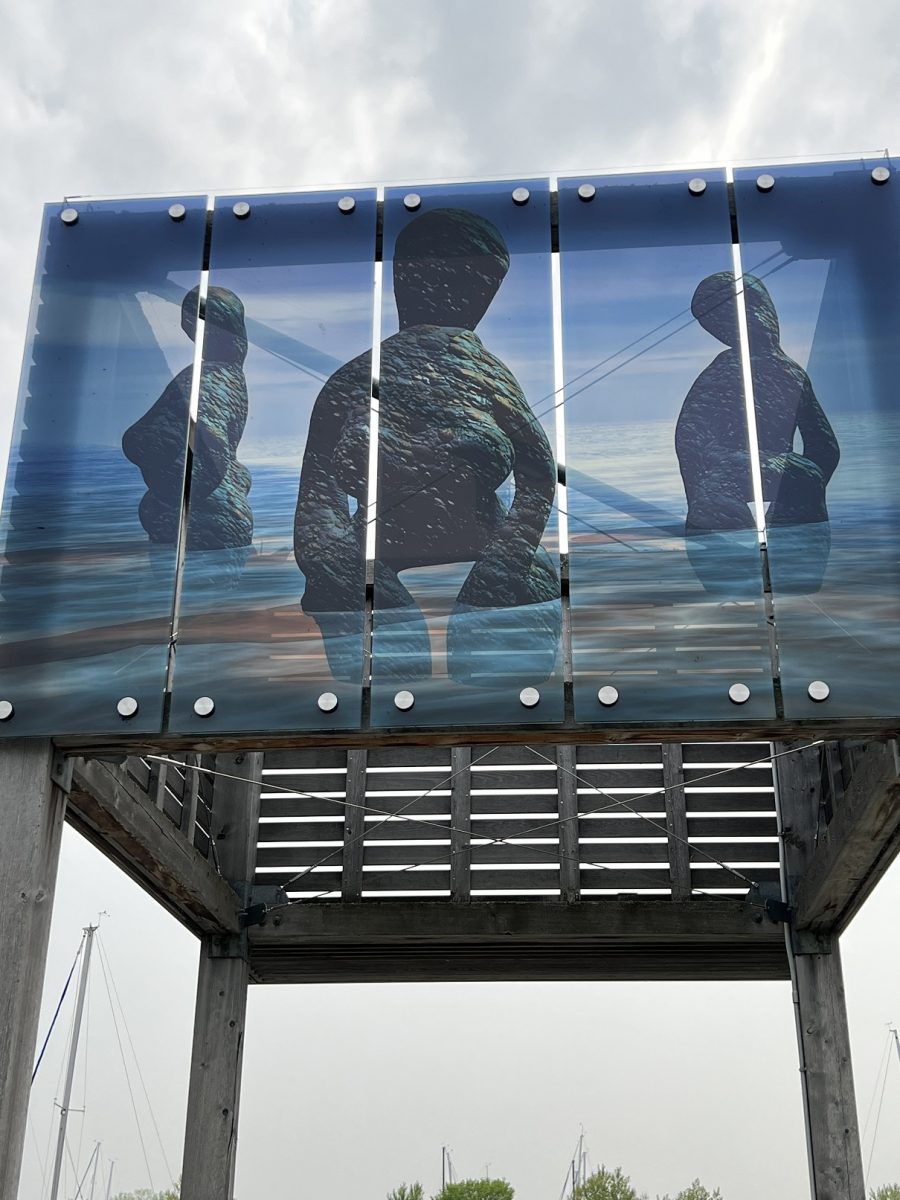
Embedded History
STUDIO KIMIIS – STEVEN BEITES &
CHRISTIAN JOAKIM
“Historically traders, voyageurs, settlers and the Métis people shared a dependence on the area’s natural resources and network of waterways. The blended surfaces of the concrete water-feature wall, depicting textures of wood grains and flowing water, represent the emergence of the Métis people from two distinct cultures.”
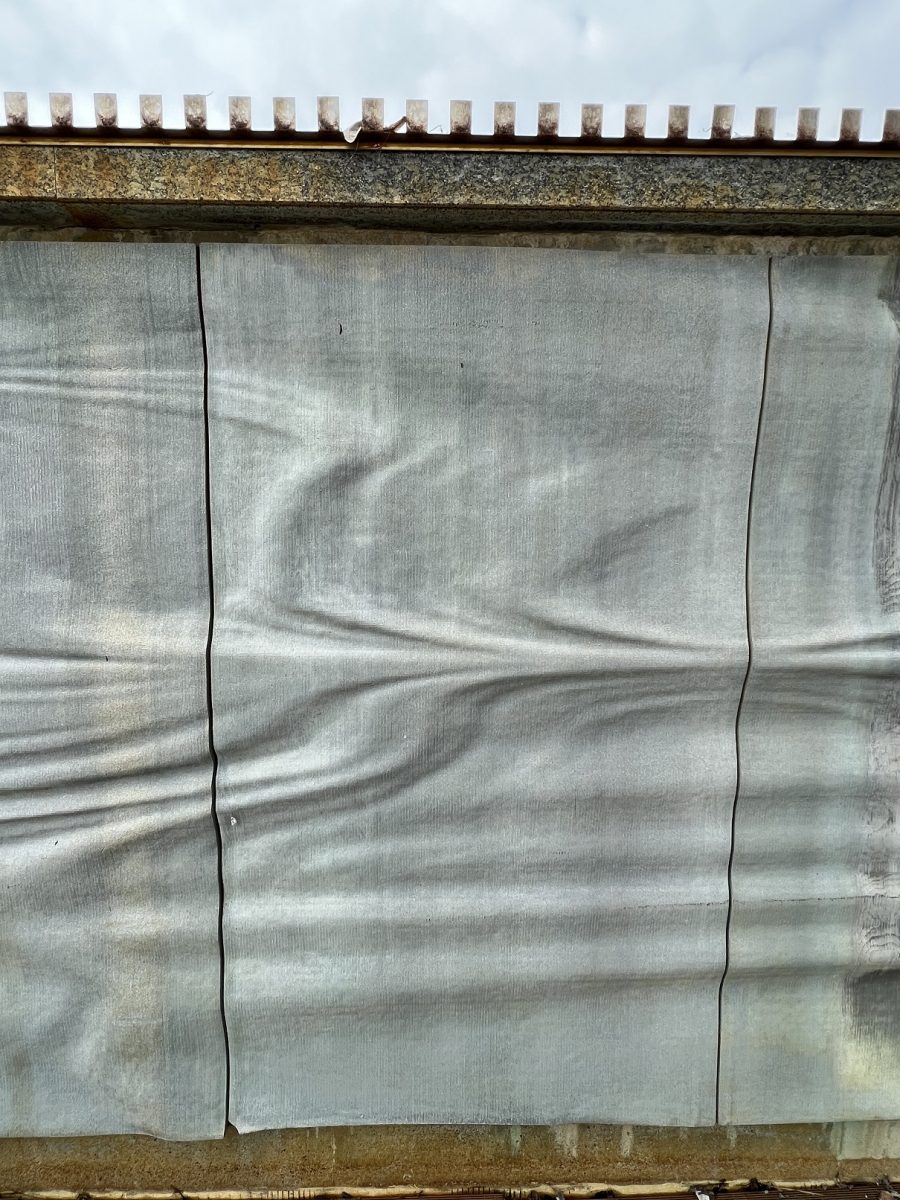
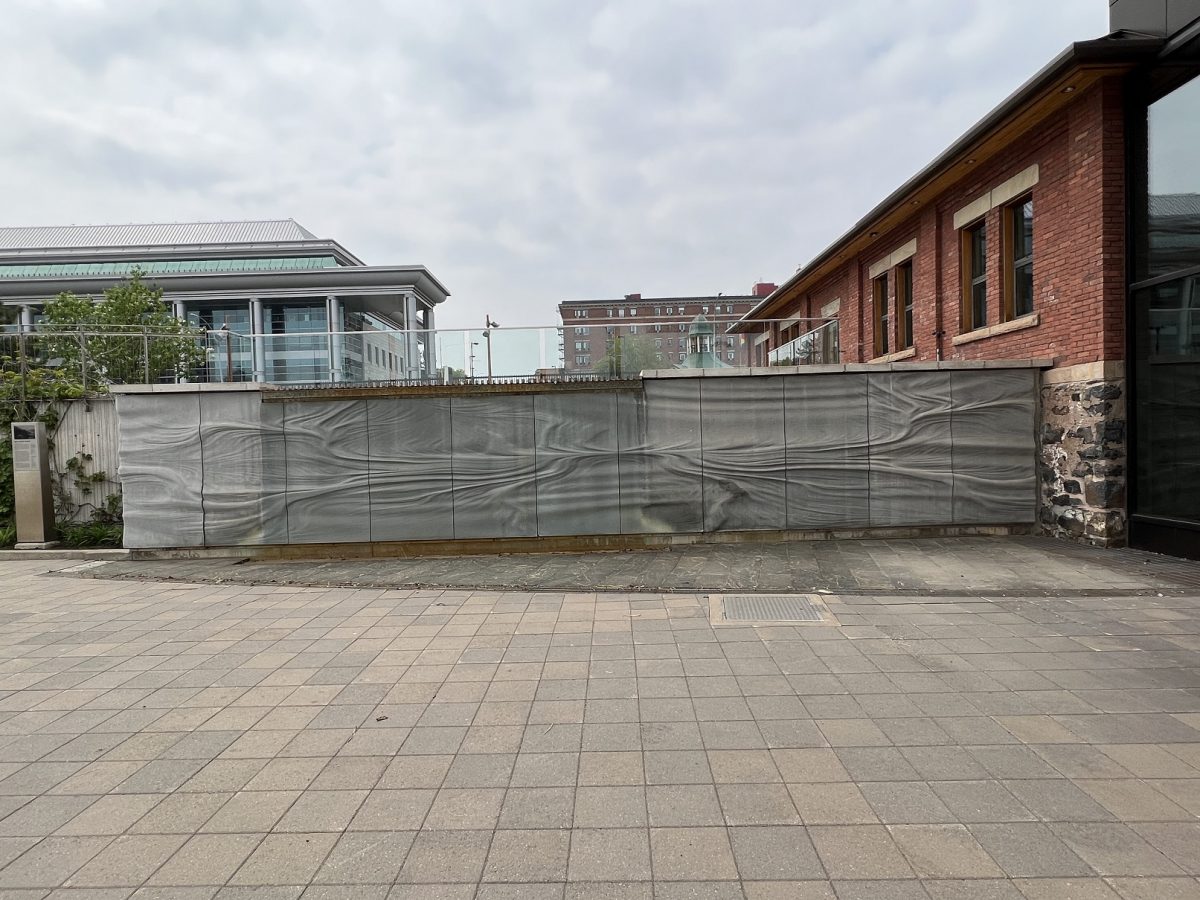
Diatom Whisper – Alchemy
INGRID KOIVUKANGAS
“Diatoms are water-based microscopic algae that account for a quarter of all the photosynthesis on earth. Tiny alchemists, they take silicon dissolved in water and turn it into intricate glass houses. The artwork depicts a sample of diatoms taken directly from Lake Superior’s unseen world.”
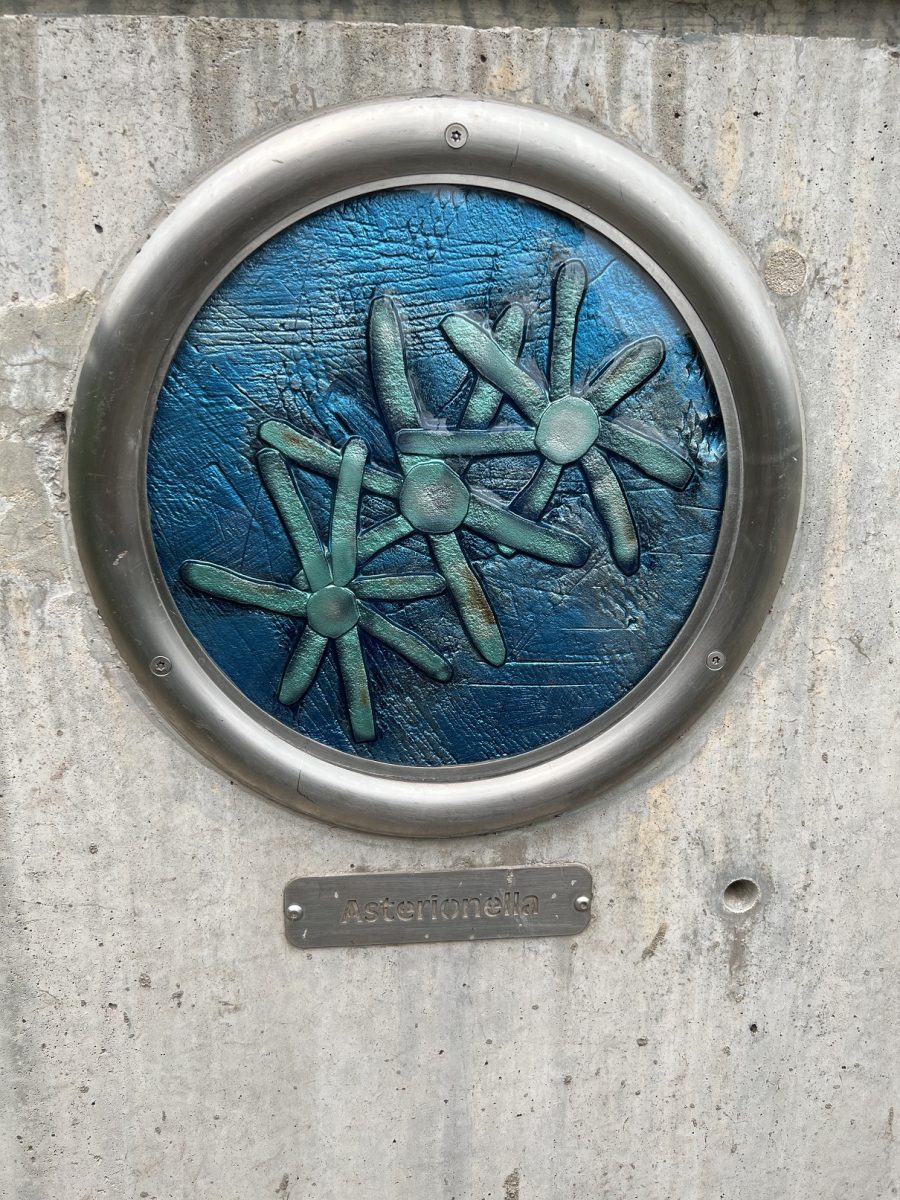
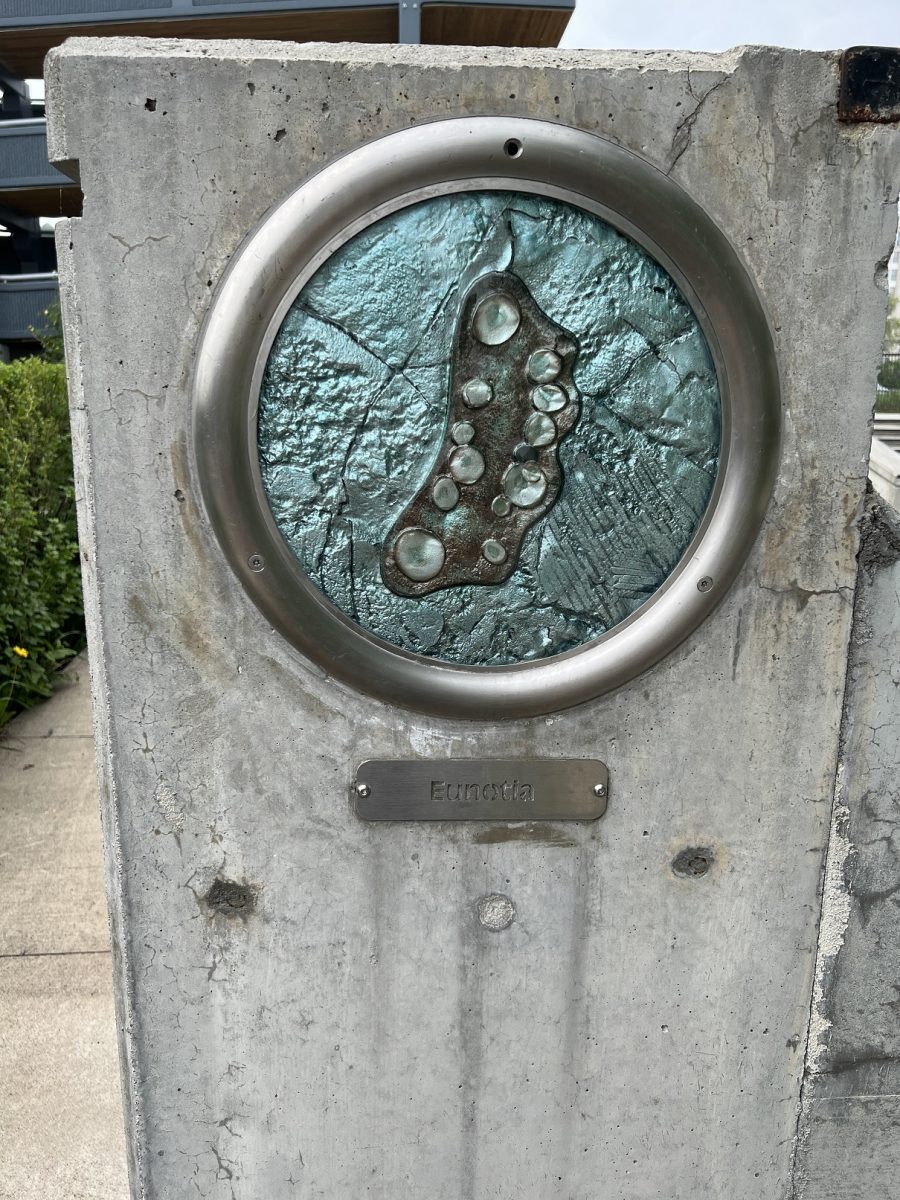
The Embedded History piece was located at the Baggage Building Arts Centre.
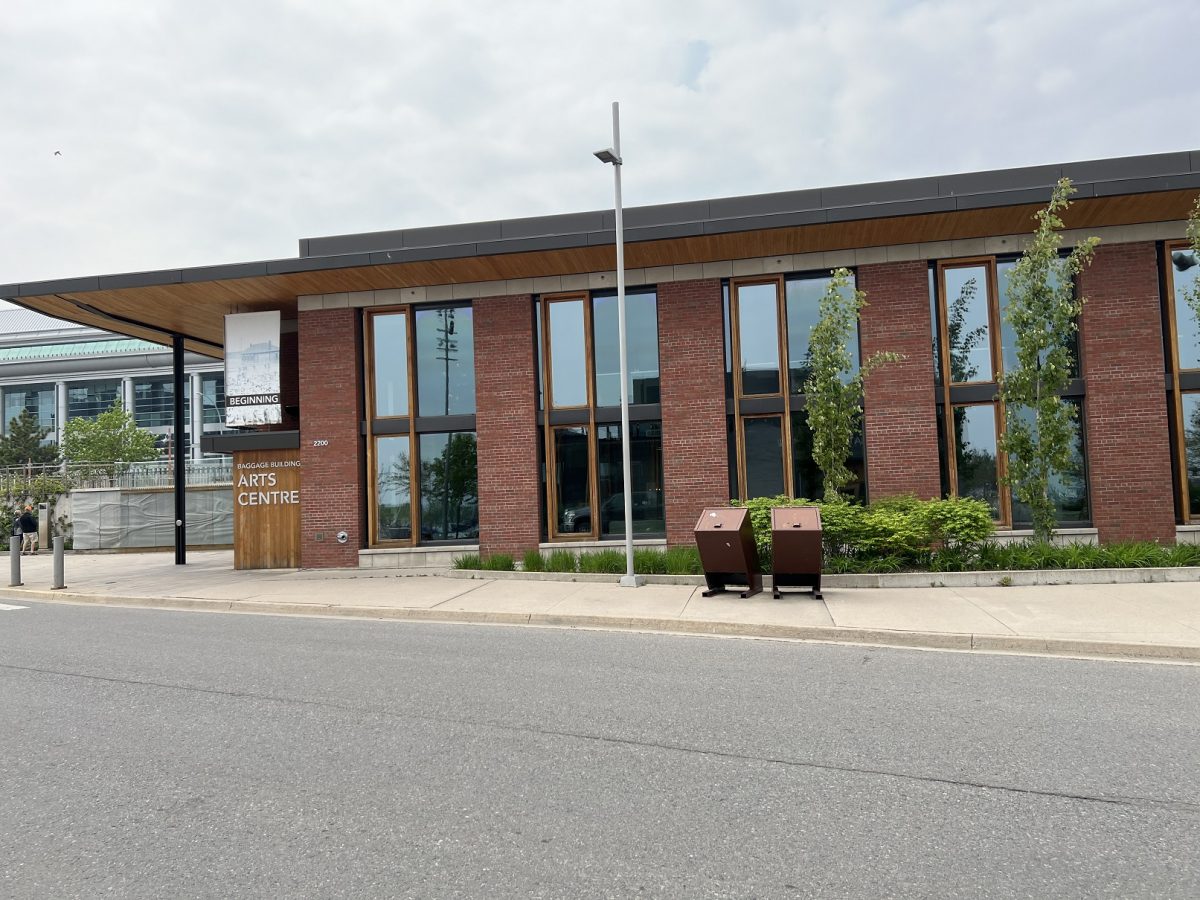
I went in and there was a mold for one of the Embedded History panels. A woman came down and I told her I was on the Public Art tour. I asked her about the building. It is Thunder Bay’s largest art centre. It is more of a community building for artists. In addition to a gallery they have workshops, talks and lectures.
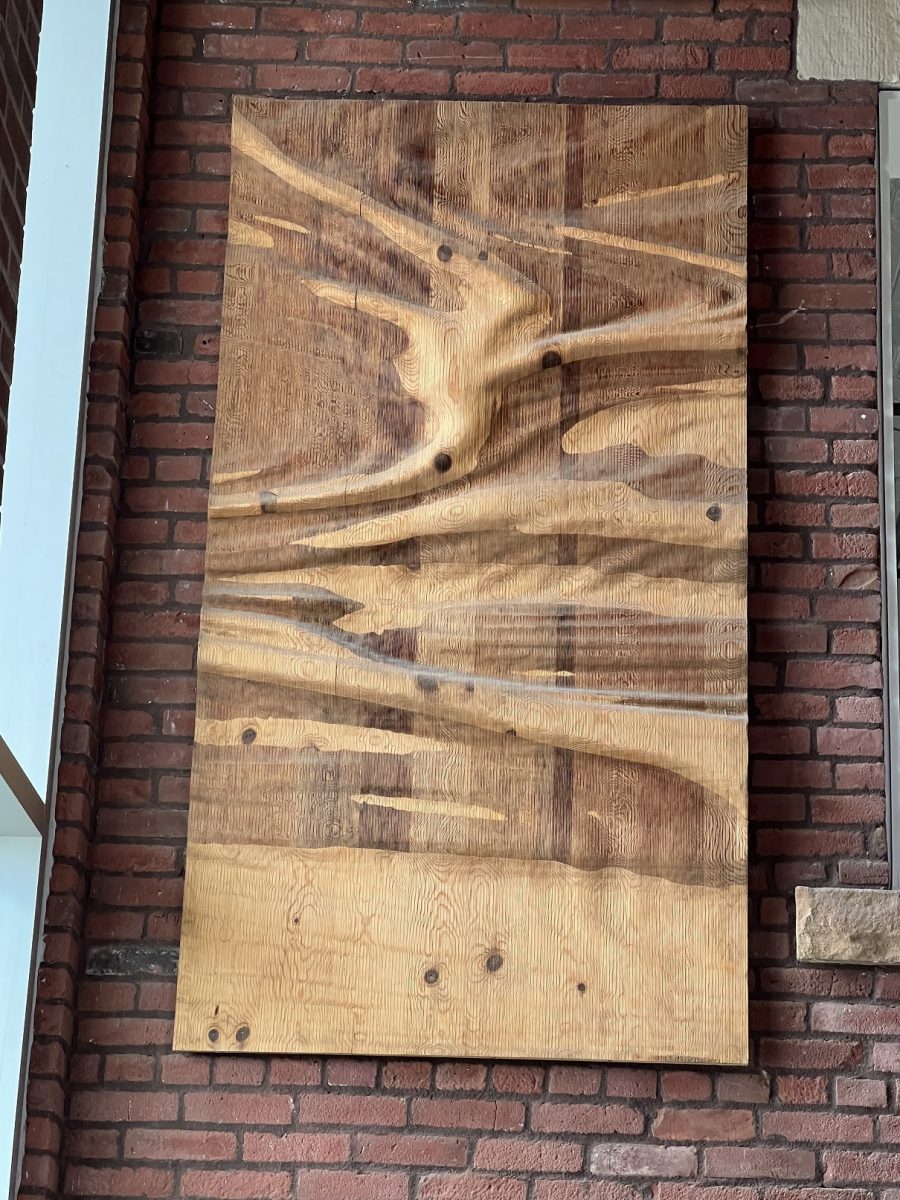
River Rock dinner. I had planned to eat at the hotel’s restaurant but they had closed it permanently (the website still had it listed). Being near the airport, there were quite a few hotels around. I called the Valhalla Inn, which was across the street. There restaurant was open. Nothing spectacular – just a Sleeping Giant Brewery amber ale and fish and chips. Then it was off to bed with snuggled pugs.

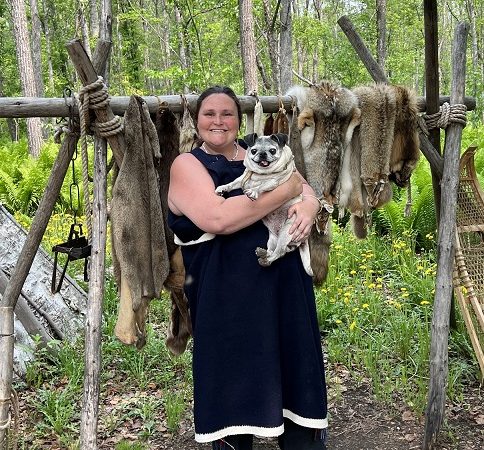
Fort William looks very interesting. So nice that it’s pet friendly. Greta is so cute posing on the grass and in the bed. Eve also looks as though she is enjoying the adventures. Sorry your lunch was a let down but your supper looked pretty yummy.
Wow…Fort William has really changed a lot since we toured it in 1977. I was just looking back at the B&W photos we took to see if any matched those you have published. So glad the pugs were able to sniff around as well; they must have enjoyed the experience. Thank you again for sharing this amazing adventure, Larry.
Yes, when I email them to ask of they were pet friendly, I was glad that they were. Not many museums/historical sites are. We’ve got another one to visit in Saskatchewan. Lots of fun ahead.
I’m sitting in the bar of a 4 star resort in Hecla Provincial Park, Manitoba. Life is good.